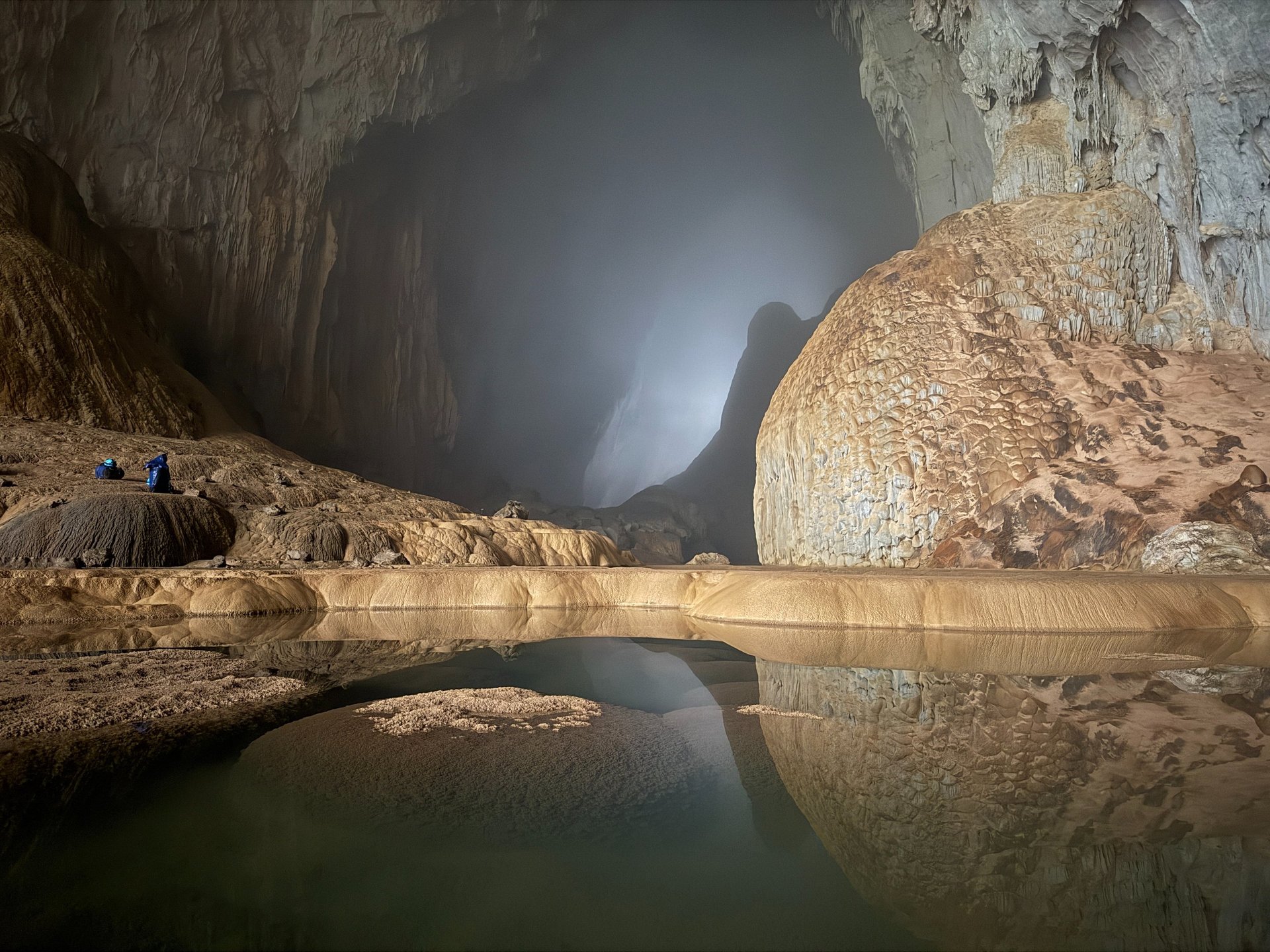
Hang Son Doong
"Mountain River cave" The Worlds Largest Cave
It all starts in Phong Nha, home to Oxalis adventures and gateway to the Ke Bang National Park, a UNESCO world heritage site. A place known in Vietnam as “The Kingdom of the Caves!” We arrived the day before the expedition started and checked into our hotel for the night provided by Oxalis adventures. The Commander Lodge is a great hotel centrally located in town with great clean rooms, pool and pool table, but mainly serves as a gathering place for Oxalis guests. We met a few other guests and tried to find out who is accompanying us on the expedition? before we are all taken to Oxalis office for our team briefing, safety talk and introduction to the expedition leaders. This is where we also got to meet all the other expedition guests, as there are 10 guests in total on any expedition. Oxalis also put on a great evening meal, it's a great chance for everyone to get to know each other before we start. They called it the "last supper" for some reason.
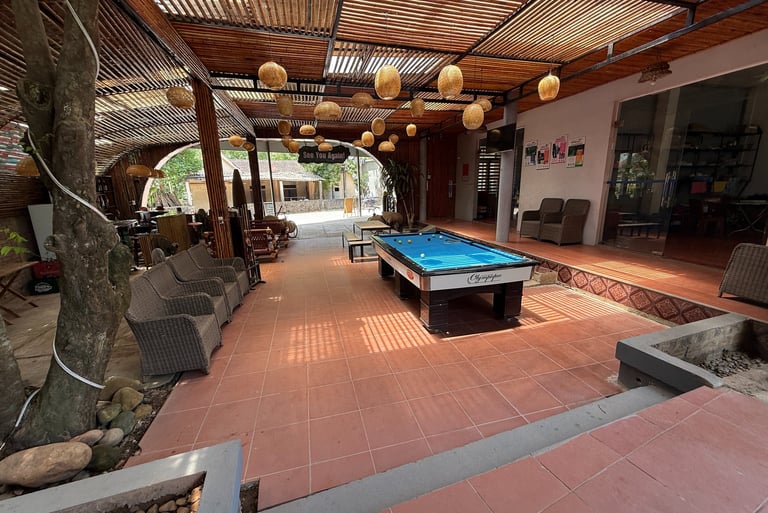

Our 6-Day Hang Sơn Đoòng Expedition with Oxalis Adventure to Explore the World’s Largest Cave in Phong Nha-Kẻ Bàng National Park, Quảng Bình Vietnam
Welcome to the Ultimate Cave Expedition
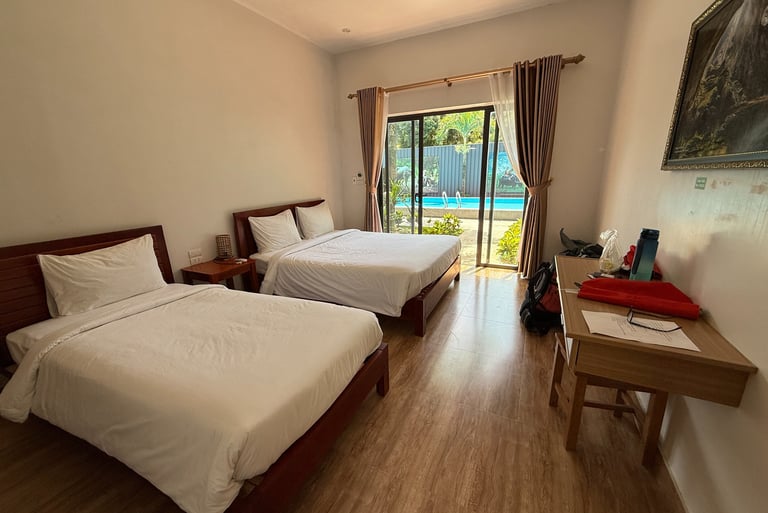

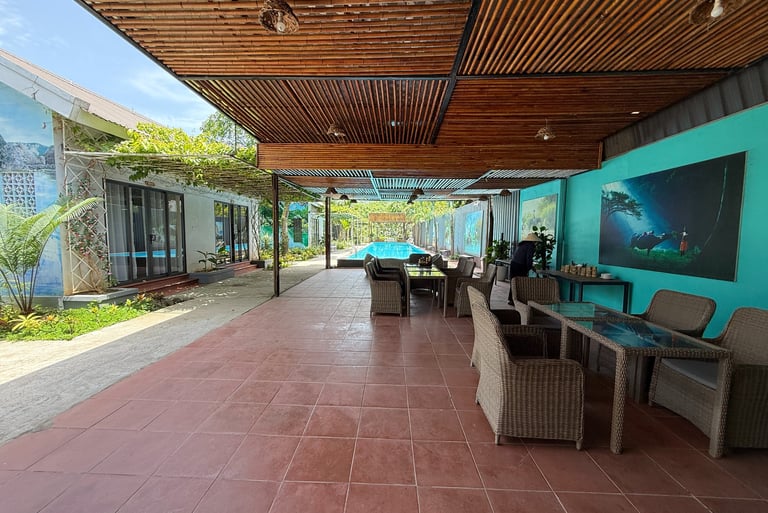

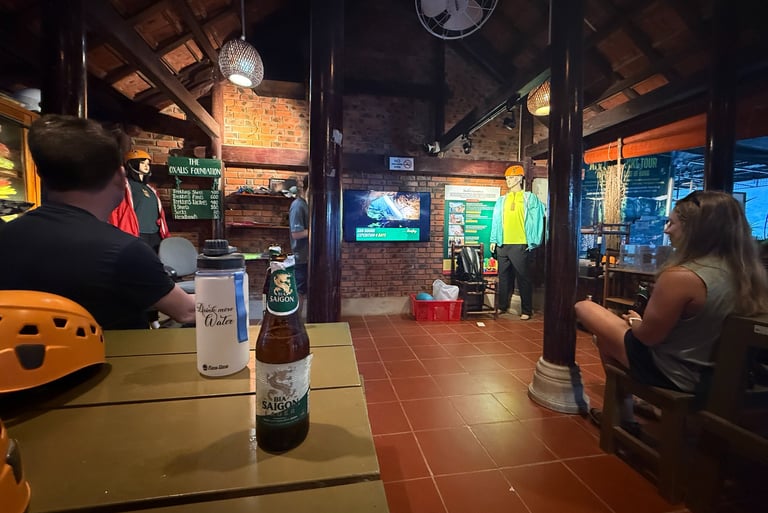

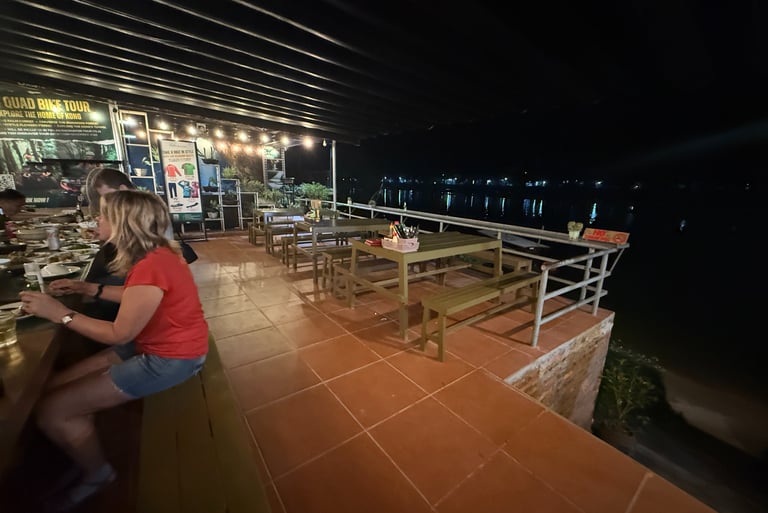

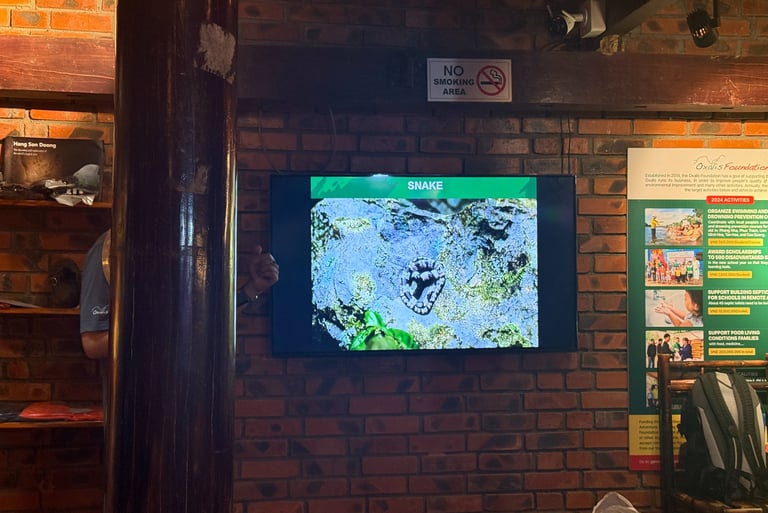

The briefing covered the expected safety aspects, but also covered things like the poisonous snakes, poisonous plants, leeches and all manner of other things that we had hardly thought about before we arrived, after all we were trekking into pristine Vietnamese jungle to get to the caves in the first place. The following morning we met in the reception of the Commander Lodge with our kit packed for the expedition and Oxalis looked after all our other things until we got back. We boarded the minibus and were off to the Kẻ Bàng National Park and the start of our adventure, posing for the team photo before we entered the jungle!

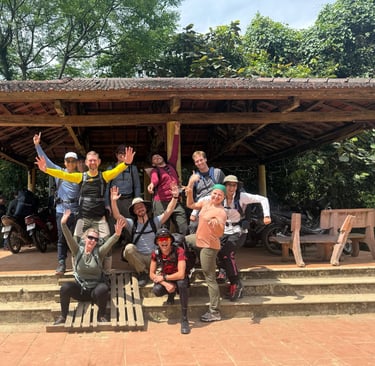
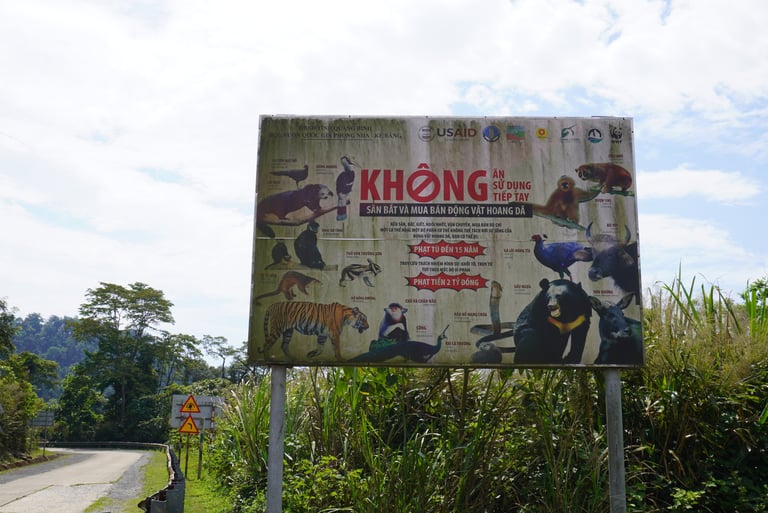

The expedition began with a 10-kilometer trek through forest trails and river valleys, it doesn't sound a great distance but it was hot and humid and there were many river crossings so your feet were wet almost from the start. We passed through remote areas of the national park and through some dense jungle, watching out for poisonous snakes and avoiding poisonous plants that the guides constantly pointed out. We were also mindful of leeches, although not poisonous, uncomfortable and can leave a nasty bite.
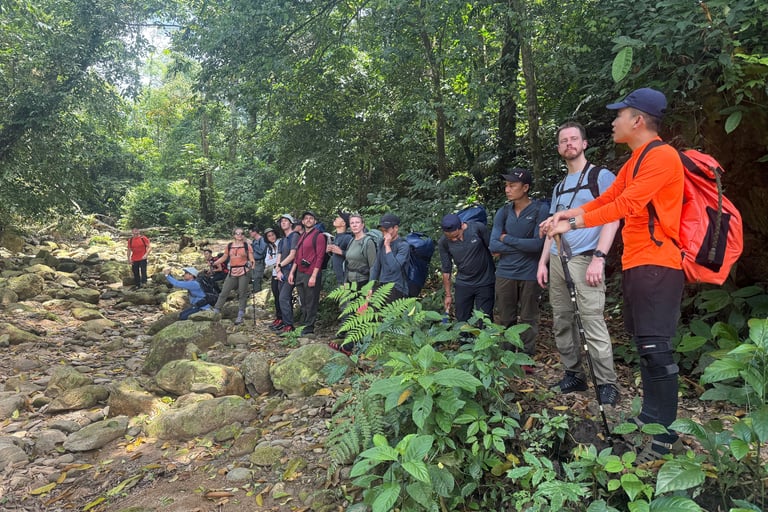

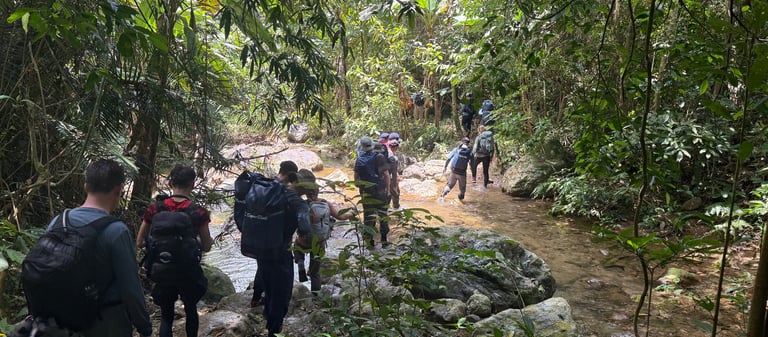

We stopped around half way to have dinner in a remote village in the jungle. Mostly cut off from the outside world, the villagers kept to themselves but allowed us the use of one of the buildings. Continuing on through the jungle, then into more open terrain following a river we finally caught a glimpse of Hang Én main cave opening. Hang Én cave being the third-largest cave in the world by volume and a taster for what was to come. Moving upstream along the river we finally arrived at Hang Én's lower cave entrance, a much smaller cave giving no idea of what was inside.
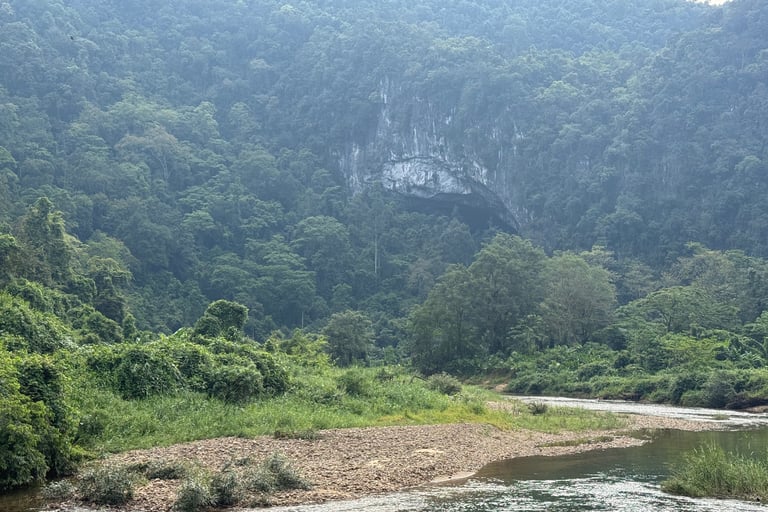

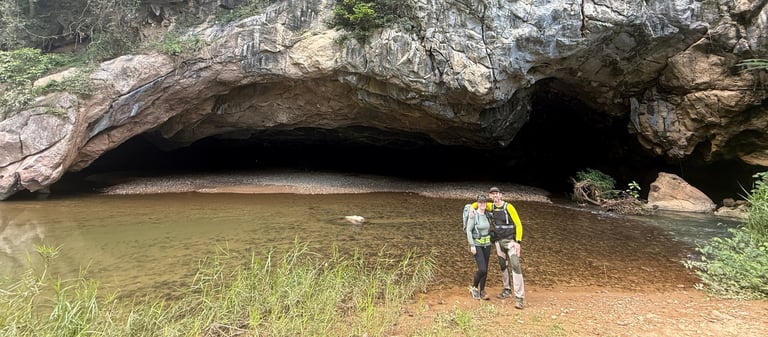

When you enter Hang Én cave the safety team fix you up with your head torch, fixing it to your helmet that now has to come out of your bag and worn at all times inside the caves, with exception of the camps in the evenings. Lights turned on and checked, we followed the guides deep into the cave following a relatively narrow passage which soon opened up into Hang Én cave proper, a vast cavernous space with a lake and river running through it. From our vantage point we could see our first nights camp, a row of tents pitched on a wide sandy bank deep inside Hang Én cave.
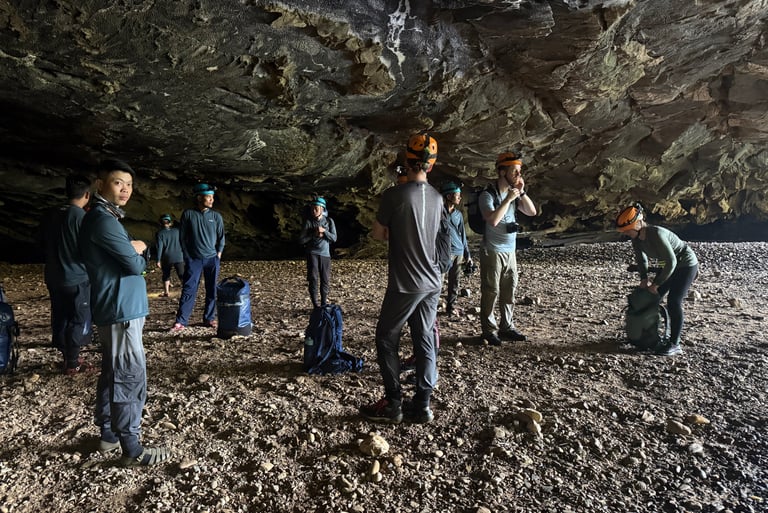

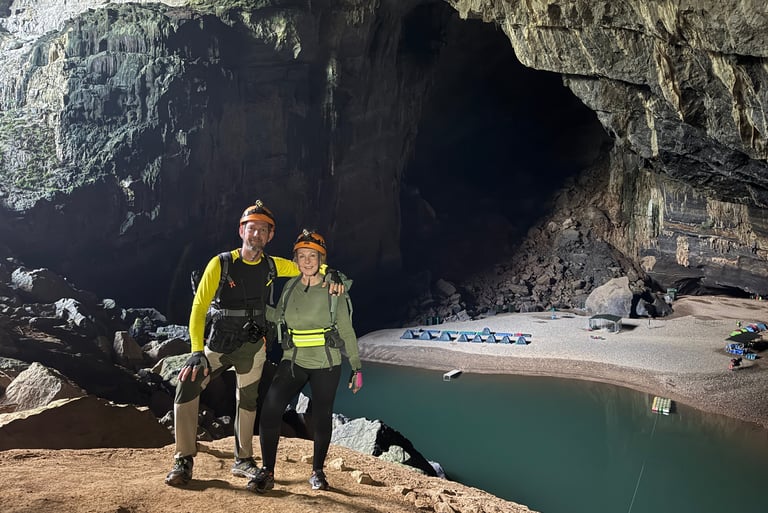

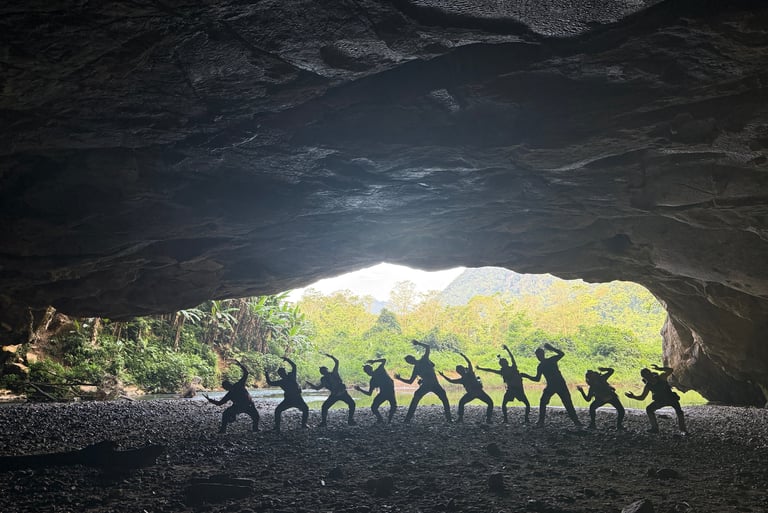

The camp is unbelievable, a row of guest tents pitched along side the lake on a sandy bank and then a porter camp pitched a little further away, with kitchen facilities and a fully set out dining area with cover. Our first challenge was to cross the lake on a raft, several guests at a time and then find our personal tent (as this will travel through the caves with us!) and settle in. Throughout the evening there was an incredible meal laid out by the chefs, an opportunity to soak up the atmosphere of the cave and have a swim in the lake, one half of which was cold and one half warm (well warmer anyway). Then as the sun set we got the chance to sit around a charcoal fire and see the cave transform, bats leaving at dusk to hunt and swallows entering to roost for the night. At times the noise of the swallows was deafening as they were entering by their thousands and as the light finally left the cave we were all plunged into darkness.
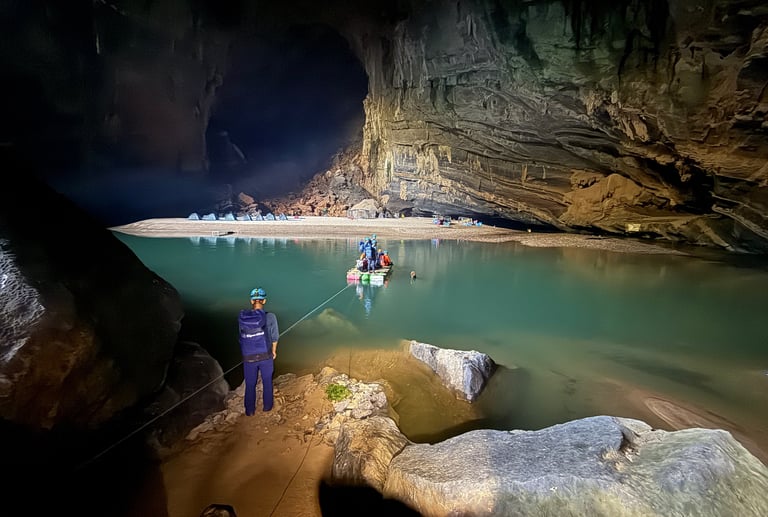

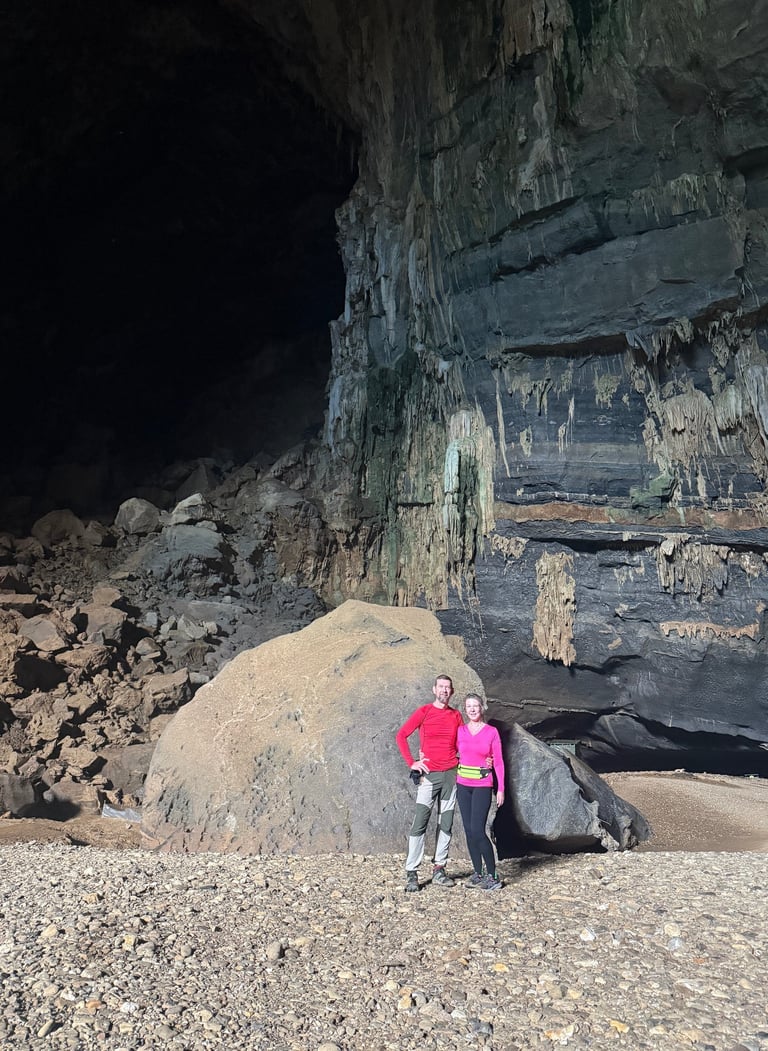

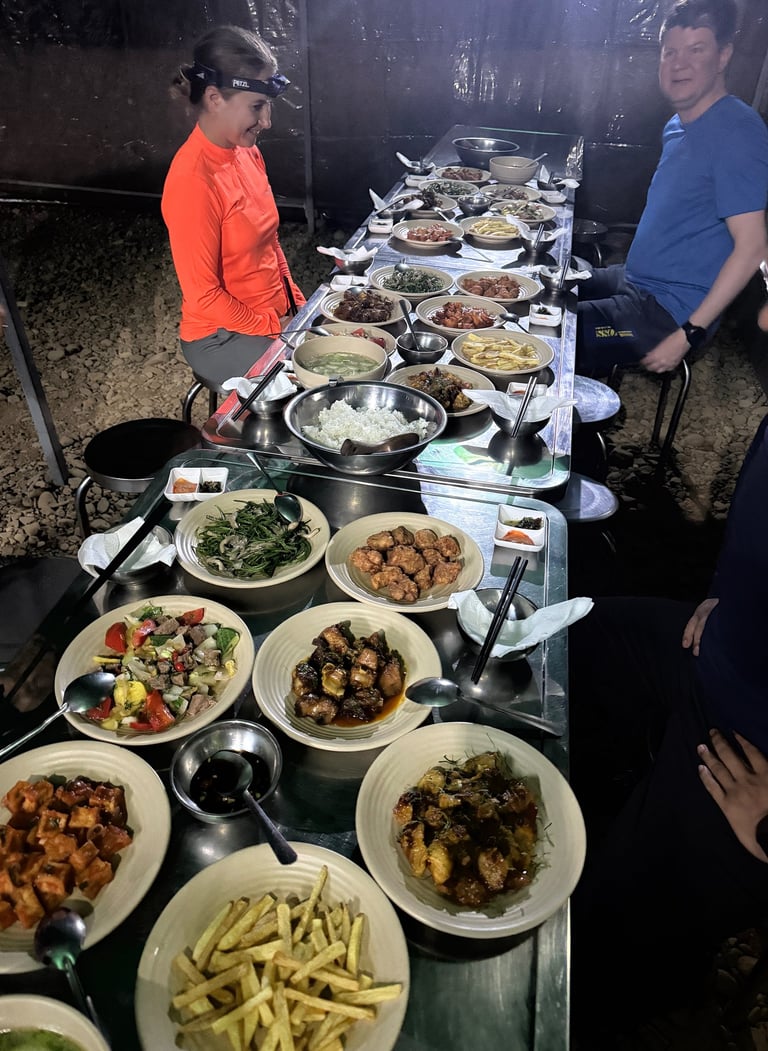


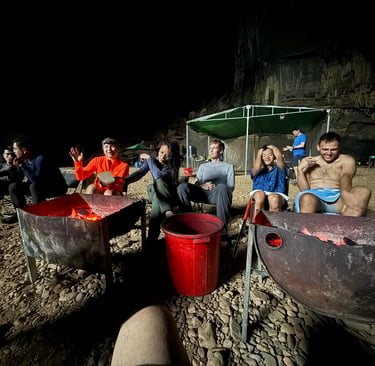
It was difficult at first to get to sleep as the noise of the swallows took some getting used too and the noise continued all night. In the morning we were again treated to an incredible breakfast and a reverse spectacle of the birds leaving their roosts and the bats returning from the hunt. After breakfast, we were given a briefing for the days activity, before we were taken high in the cave up to a vantage point at the back of Heng En, giving an incredible view back to the camp, lake and main cave entrance. Following this we continued through Hang En cave around a kilometer and a half until we reached the rear entrance and the continuation of our jungle trek to Hang Son Doong.
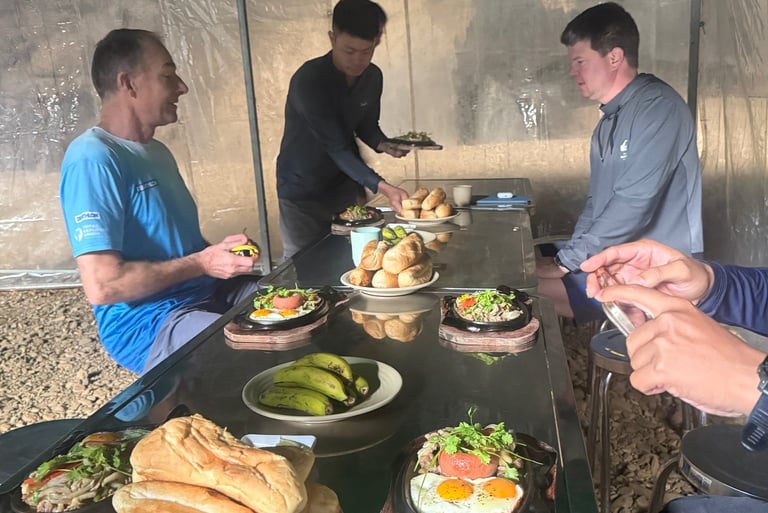

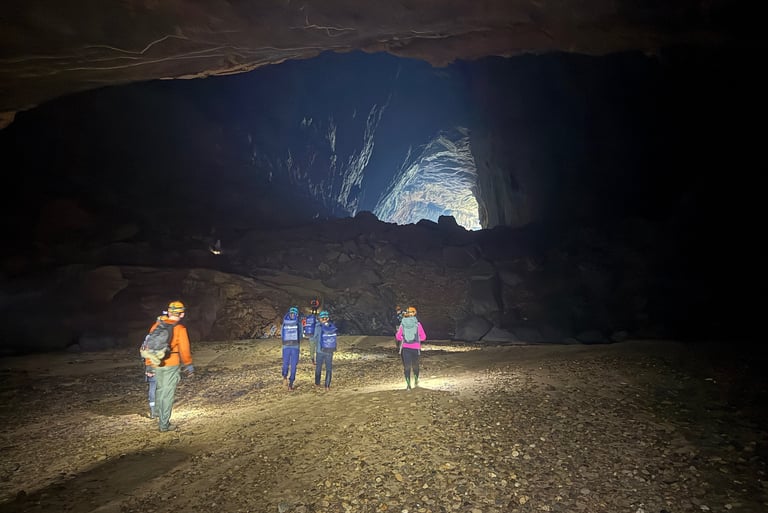


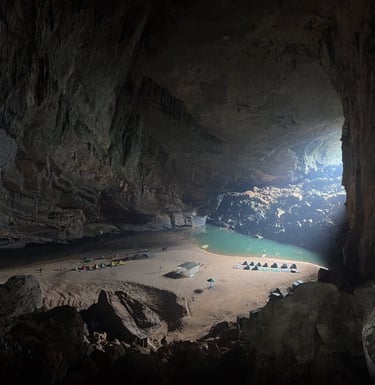
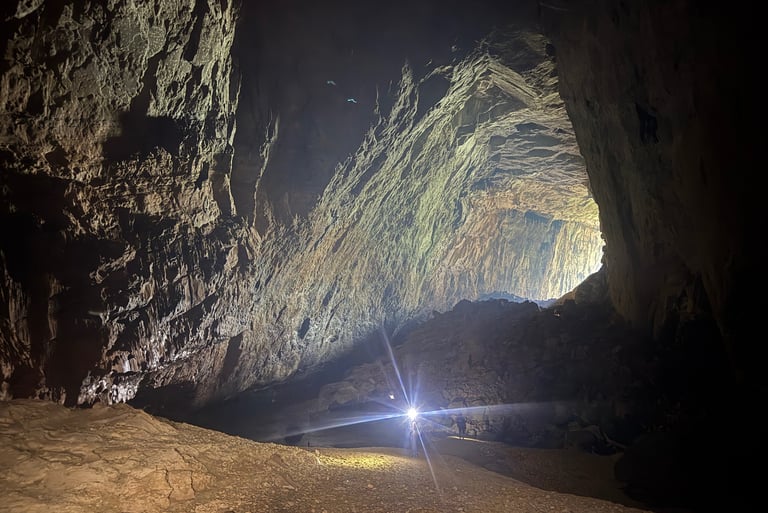

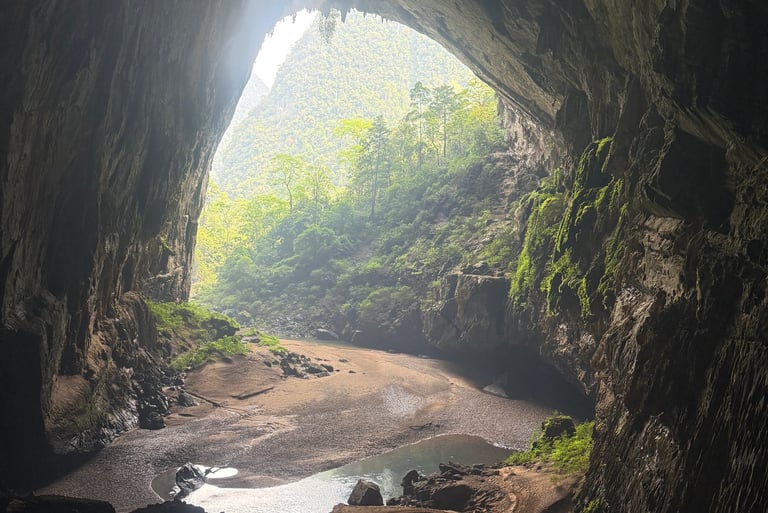

The rear entrance to Hang En cave is enormous and the sight of the sunlight and the dense green jungle almost takes your breath away. We had the opportunity to linger a while to take photos and to take in the enormity of the place before we continued out into the jungle again, through the valley and on to Son Doong's entrance. The jungle section was only around a kilometer and a half long long but criss-crossed through a river that runs though the valley. This section of the valley is believed to be a former section of the cave system that once connected Hang En and Song Doong together forming one big super cave, but has long since collapsed over millions of years.
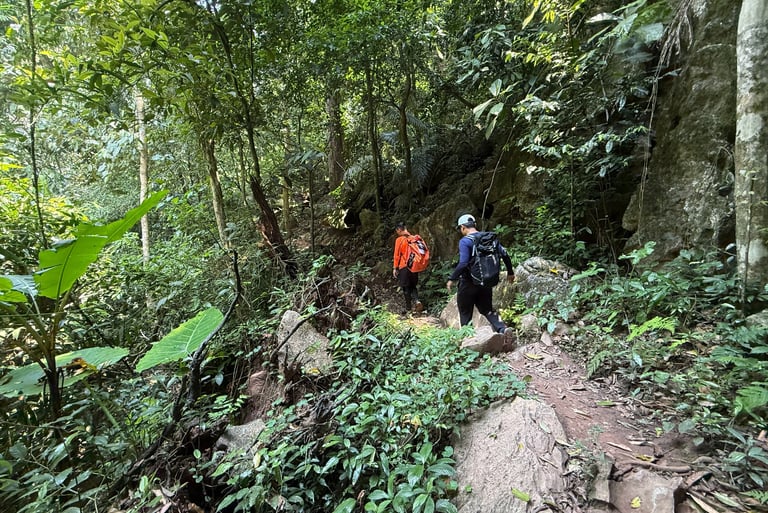

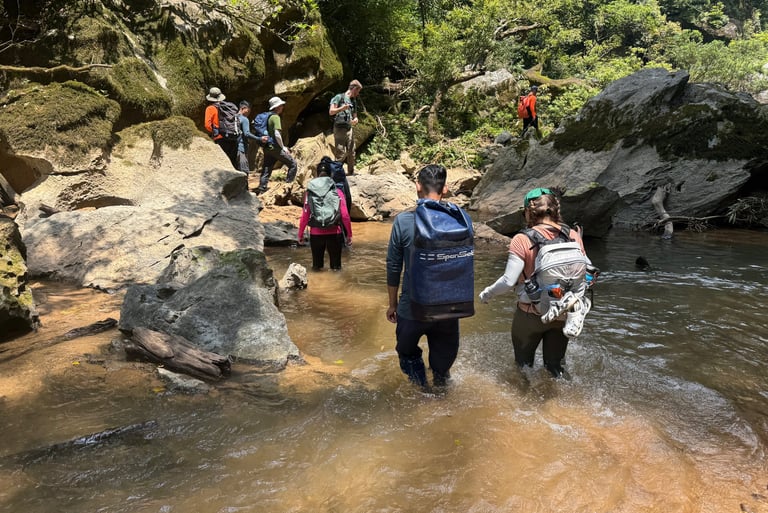


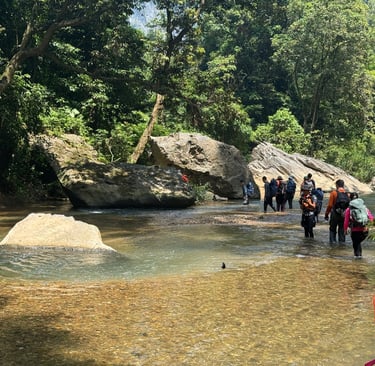
Just before arriving at Hang Son Doong cave entrance we stopped for lunch and it was time to be kitted up with our climbing harnesses, as entering Hang Son Doong could only be done via a 90m rappel, a baptism of fire right at the start! After kitting up, it was a short walk and a few sets of metal ladders to the entrance of the cave. A surprisingly small, but very formidable entrance with mist rising like a dragons breath through the teeth like stalactites hanging from the roof of the cave.
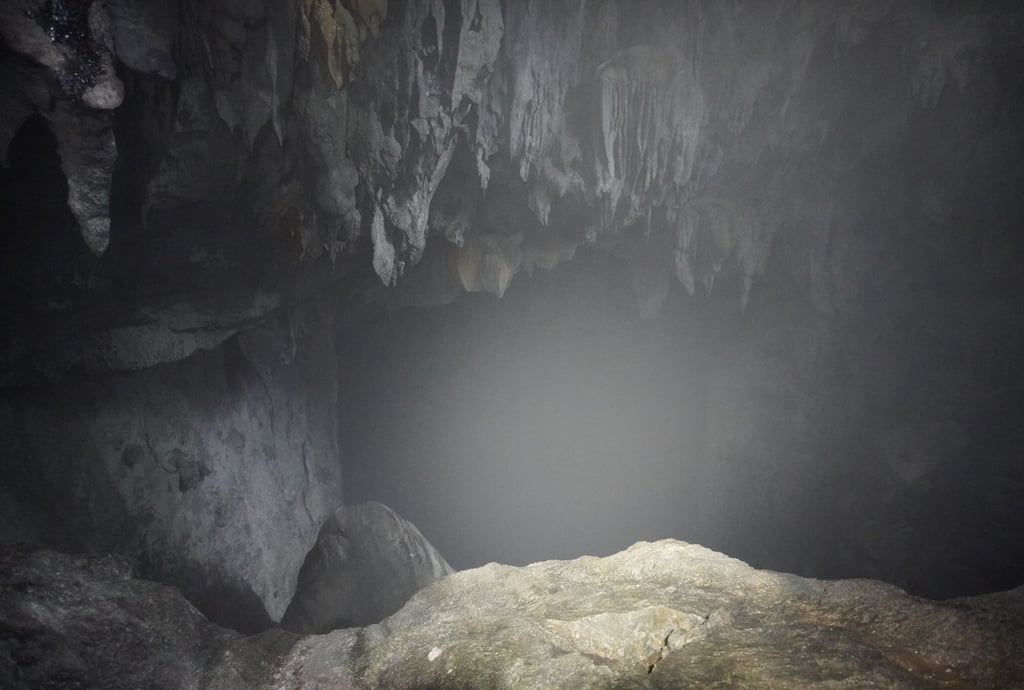

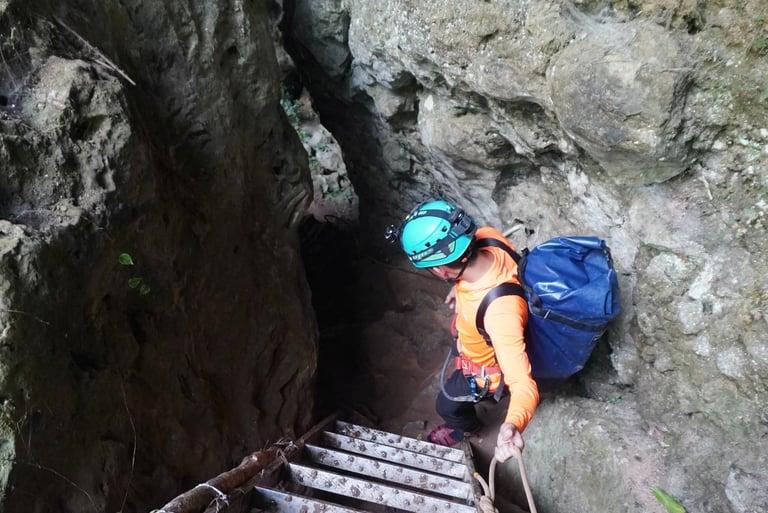

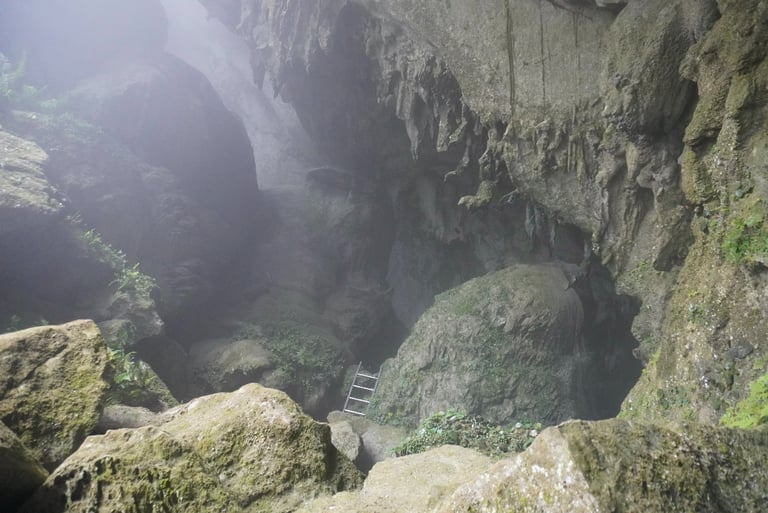

One by one we were led by the safety team to the first roped section. This was a 45m steeply sloping section which you had to lower yourself down via a knotted rope (you also had a safety rope attached just in case) arriving on a small ledge, stopping briefly for a photo opportunity before transferring onto another steep section. This section was achievable without the need for the safety ropes. When the whole group were down we were led across a muddy section around an underground lake and then up quite a steep section of rocky terrain. We were told to look back and take in the view, which seemed slightly difficult as we were in a vast, light swallowing cavern, our head torches only giving a hit of what was around you. one by one the Oxalis team turned on their super bright cave display lights and illuminated the whole cavern, allowing us to look back on the entrance, but also to take in the sheer size of this first section of Hang Son Doong, and wow what a sight!
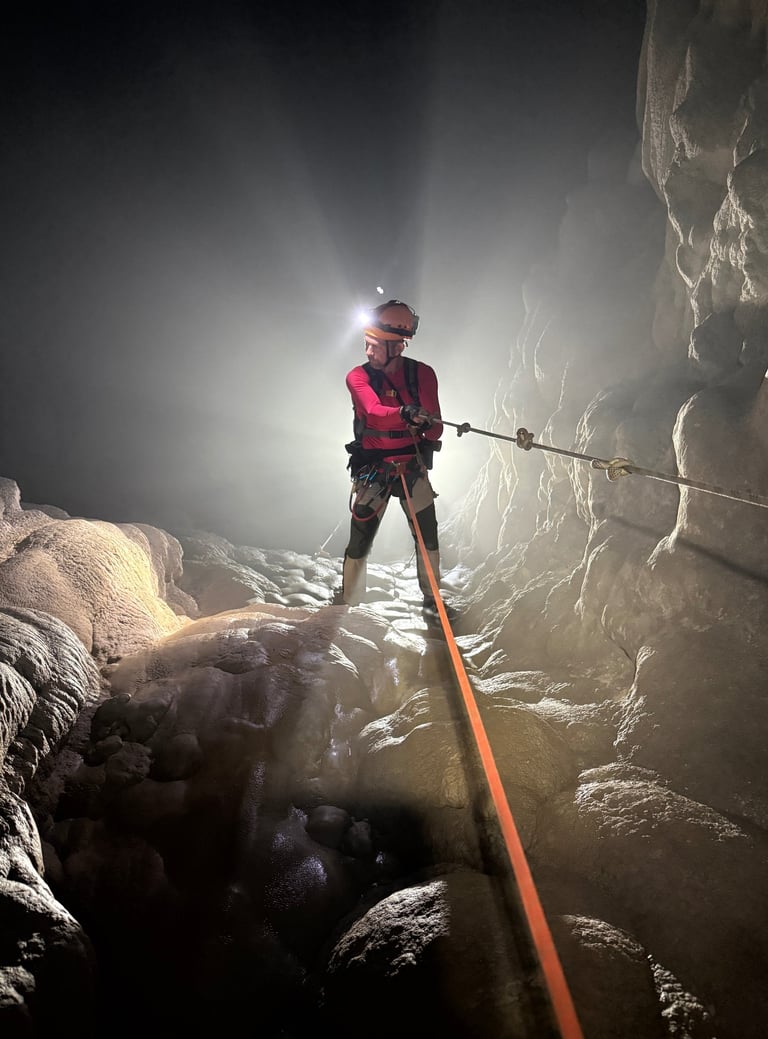

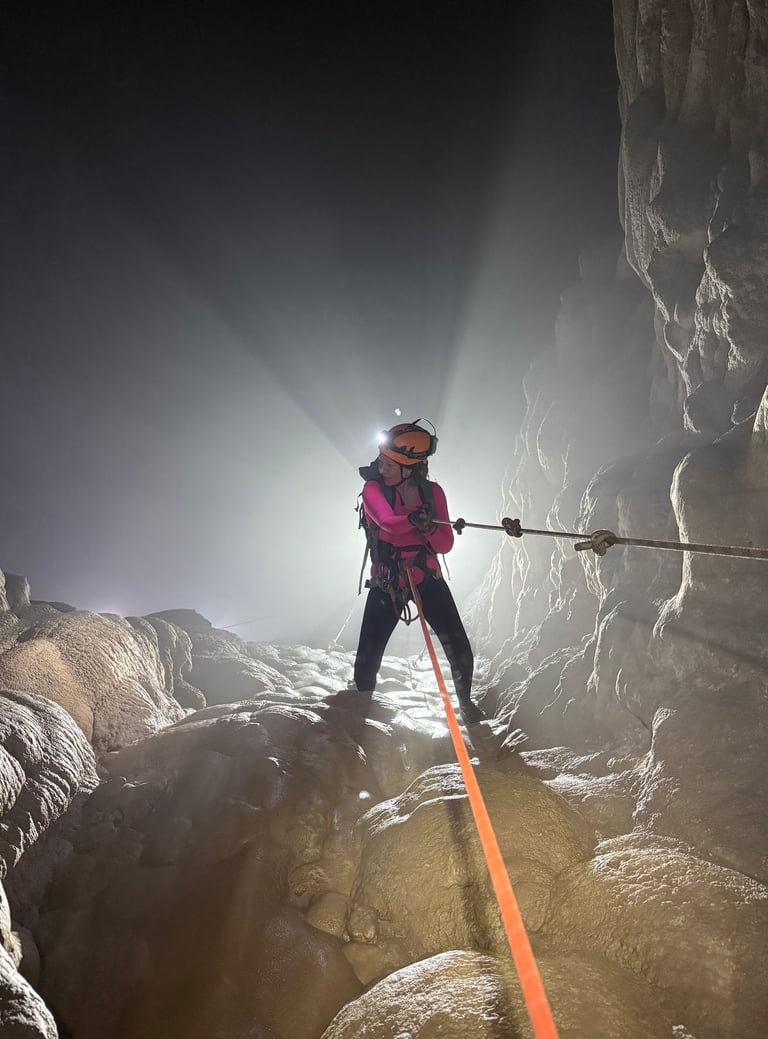

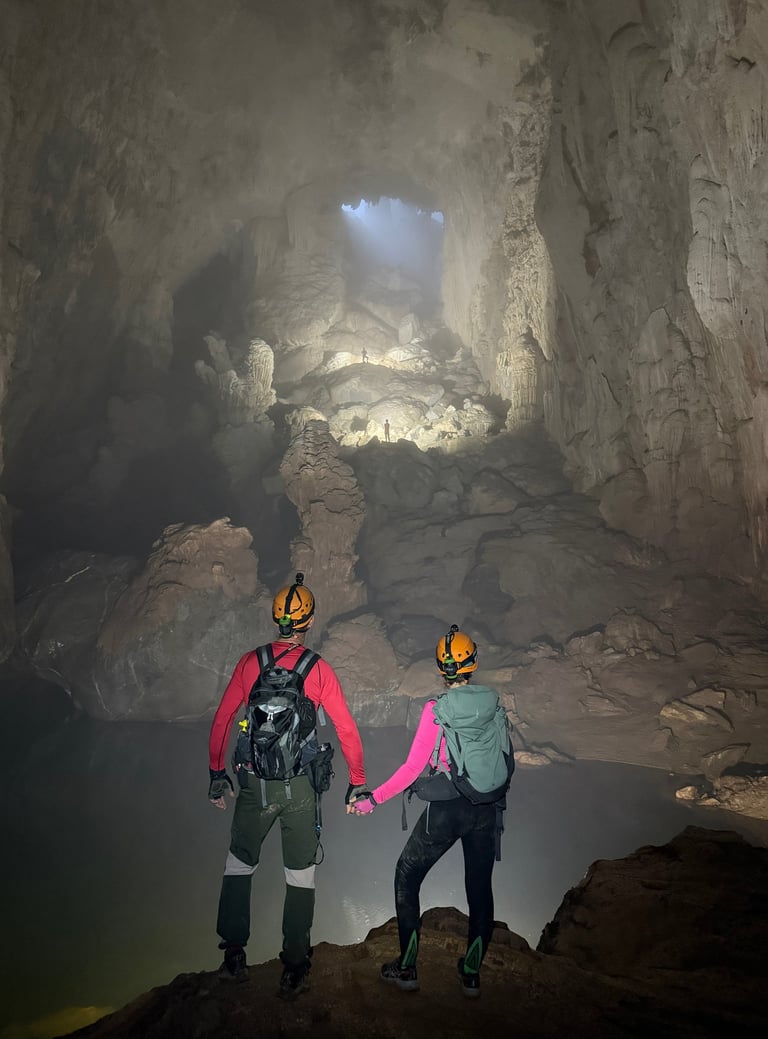

From there, you continue on through undulating sections of cave until you meet your next couple of challenges, two roped river crossing. One of which is through waist deep, quite fast flowing water. We were split into two groups and each group crossed carefully, whilst keeping hold of a fixed rope for support. Other sections looked like we were walking through the mouth of a dragon, with its sharp teeth bearing down on us.
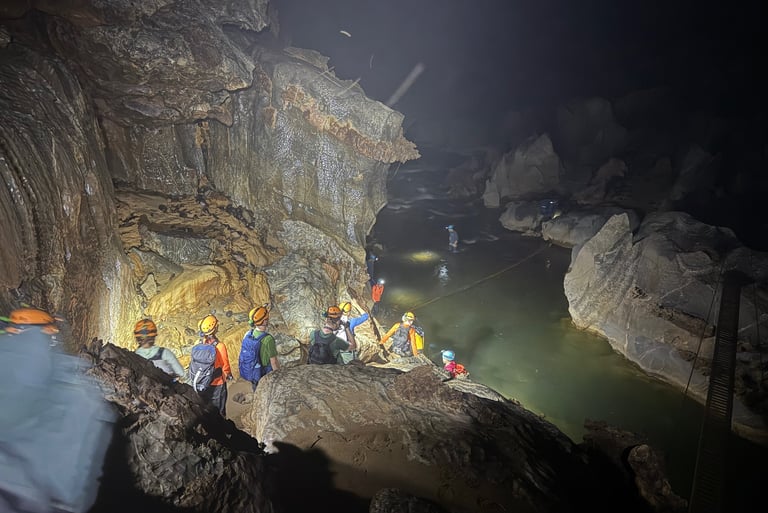

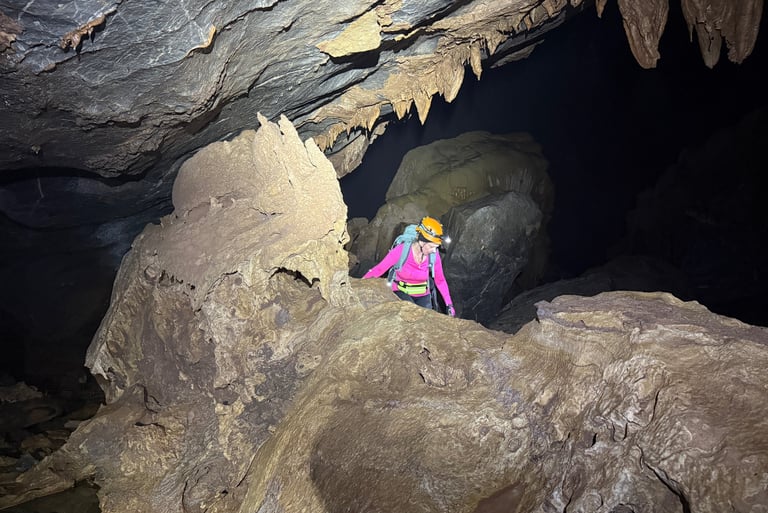

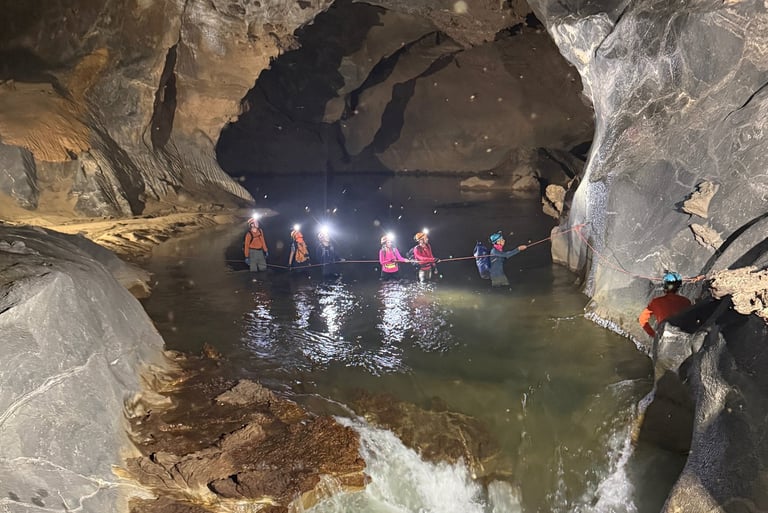

Eventually, after navigating some small scrambles and passing huge calcite formation. We reached a section of the cave known as 'Hope and Vision'. This was the first chance to see a glimmer of light from the first doline (a section of the cave where the roof has collapsed allowing natural light to enter), but also another point where the Oxalis team use their mega lights to light up the whole passage, once again giving you an idea of the immensity of the cave. Apparently in this section of the cave there is enough room to fly a Boing 747 through! It also gave you insane photo opportunities of the 'Hope and Vision stalagmite' the largest stalagmite in the world at around 80m in height and a chance to look through the cavern to 'The hand of Dog' stalagmite, another huge stalagmite at approximately 60m in height. All of this put into perspective by members of the Oxalis team who stood at strategic points to give scale to the pictures.
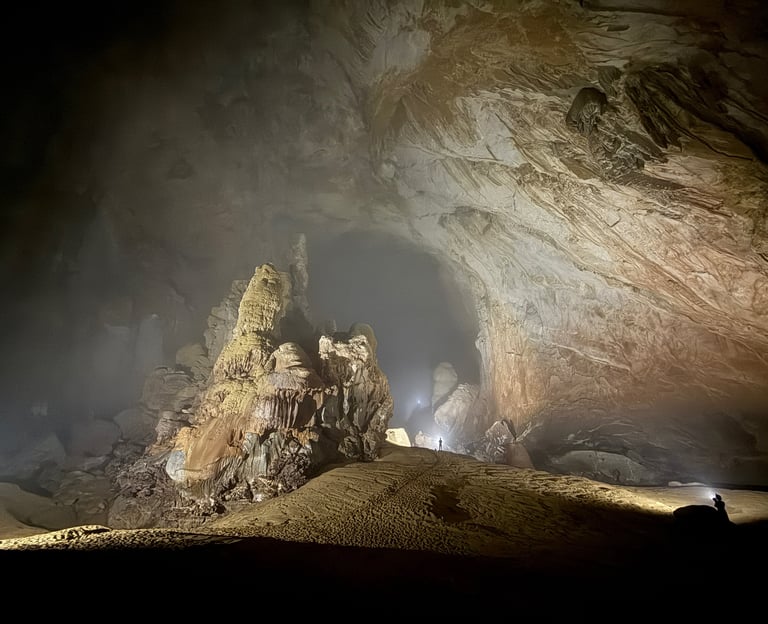

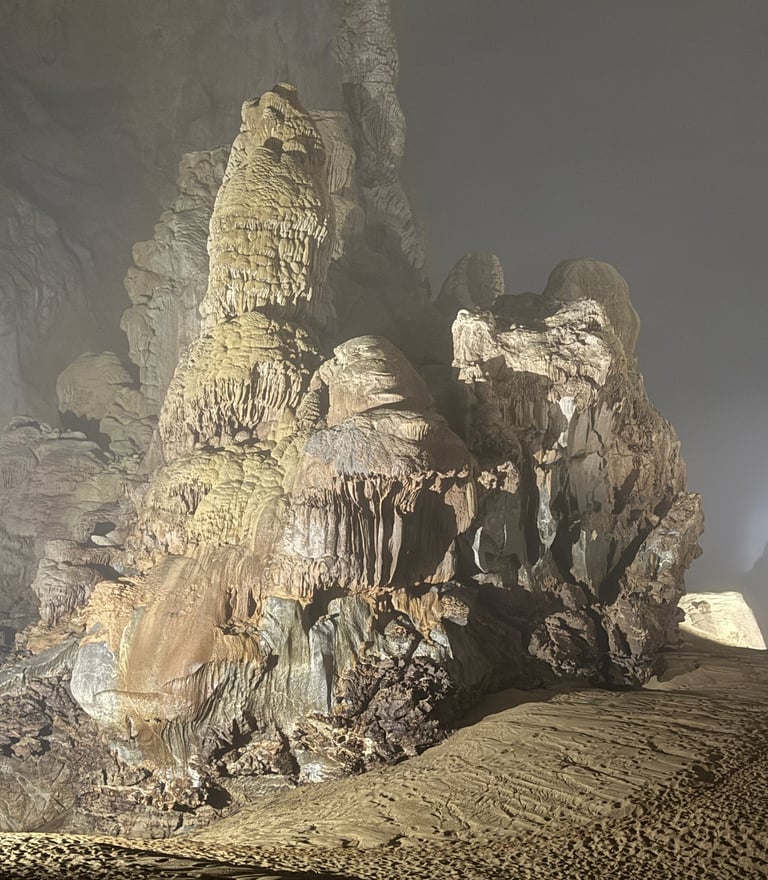

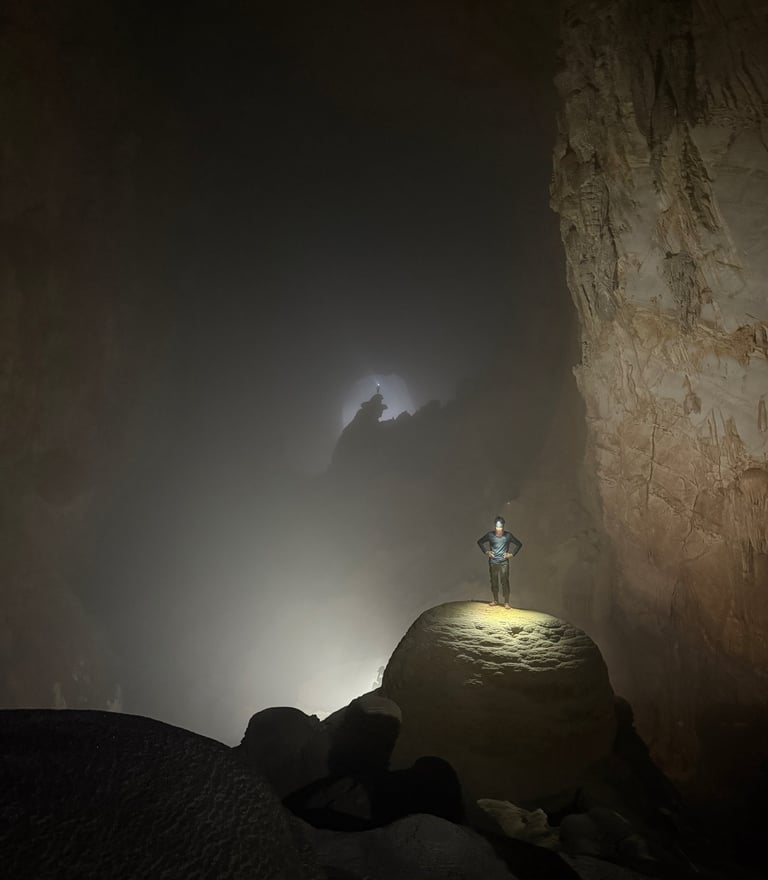

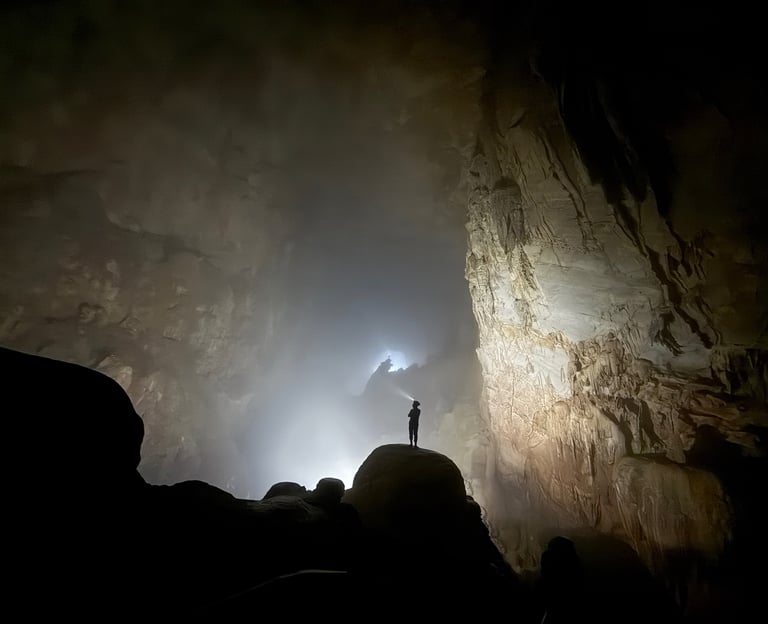

Continuing on through the Hopes and Dreams section we followed and undulating path, over boulder sections in places climbing up and passing the Hand of Dog where we got our first view of doline 1 and the first camp in Son Doong. We set up my camera here for a time lapse, and one of the Oxalis team retrieved it later in the evening. We then proceeded through a section known as the "Level Playing Fields' until we finally reached camp one for the night. Another exceptionally well set out camp on a sandy plateau a hundred meters from the climb leading to doline 1.
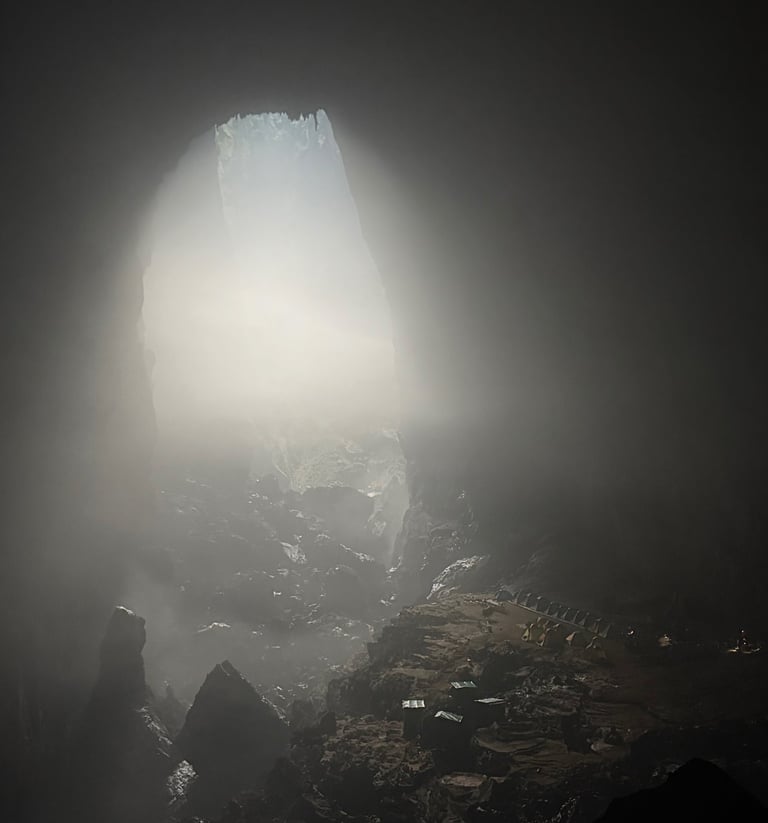

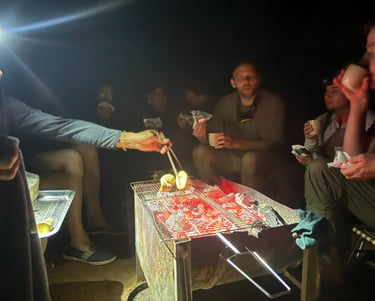

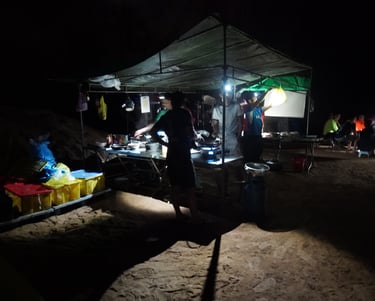

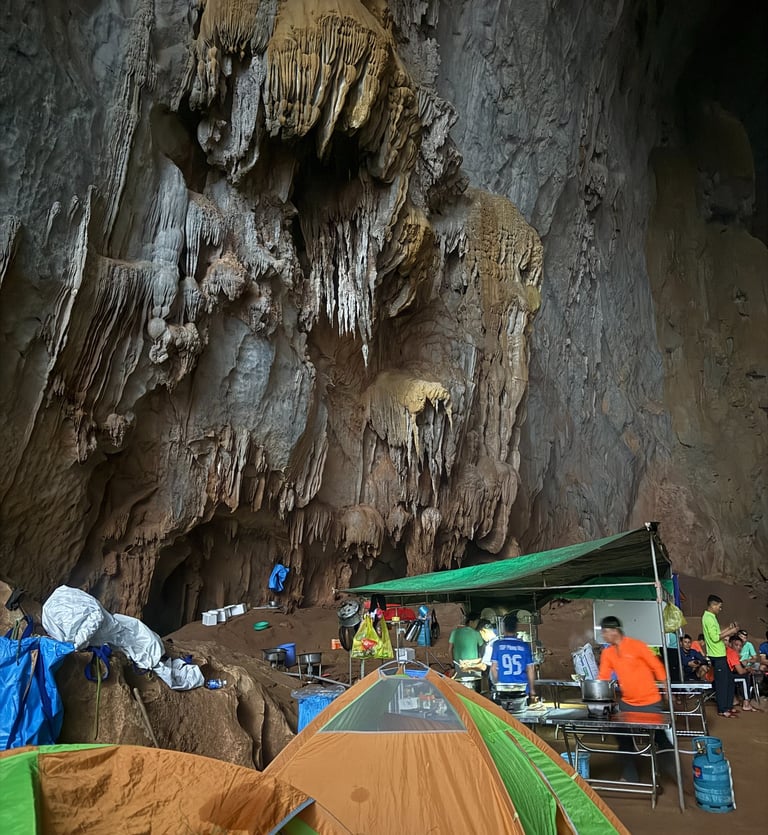

That evening we had the chance to go for a swim in one of the underground lakes. it was quite a steep trek down to the lake, and the water vas very cold, we also had to go in fully clothed because of sharp rocks and also wear a life vests just in case we got into difficulty with the cold or environment. The following morning after breakfast we continued on with a descent through some large boulders and a couple of tight places through the fallen rocks until we came across one of the most bizarre features of the whole cave. A perfectly formed round hole through the solid rock, just like it had been drilled, but with a massive machine, or course it hadn't, it was water erosion over millions of years on a perfect scale. The Oxalis team called this the James Bond hole and were quite keen to get everyone in the correct James Bond pose for a photo.
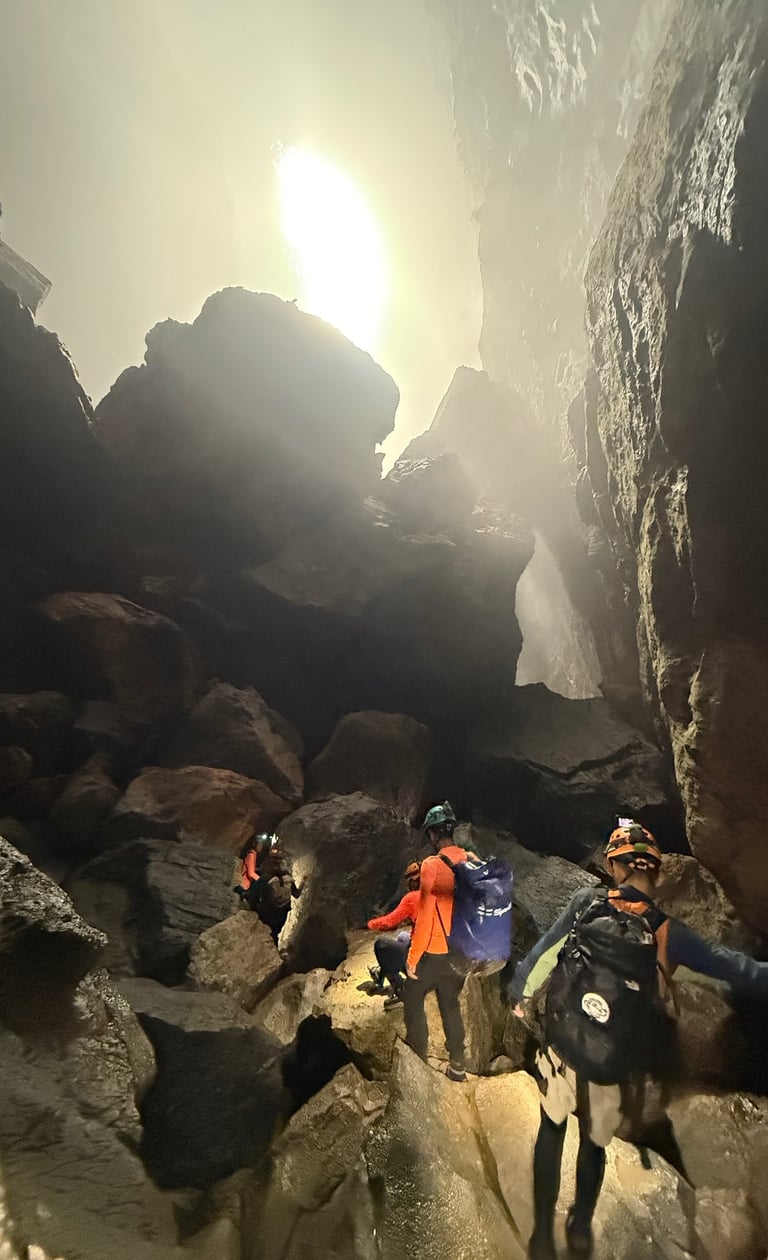

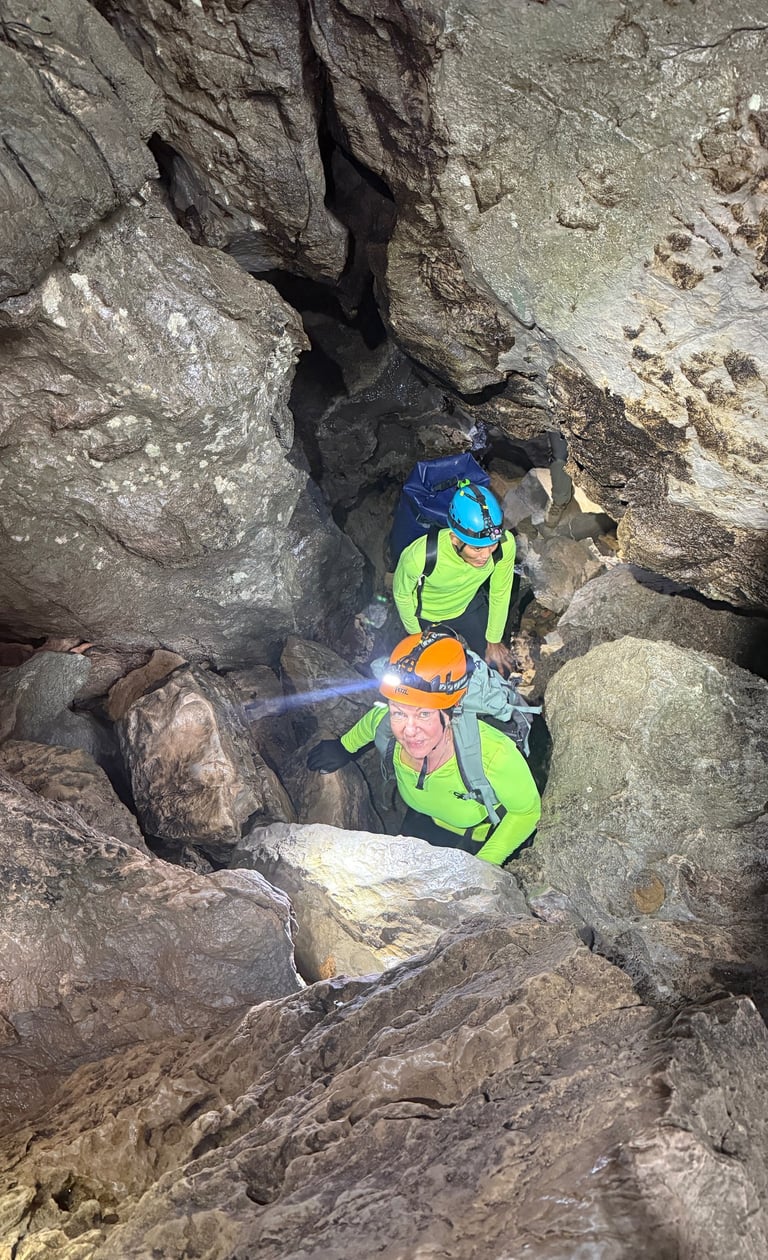

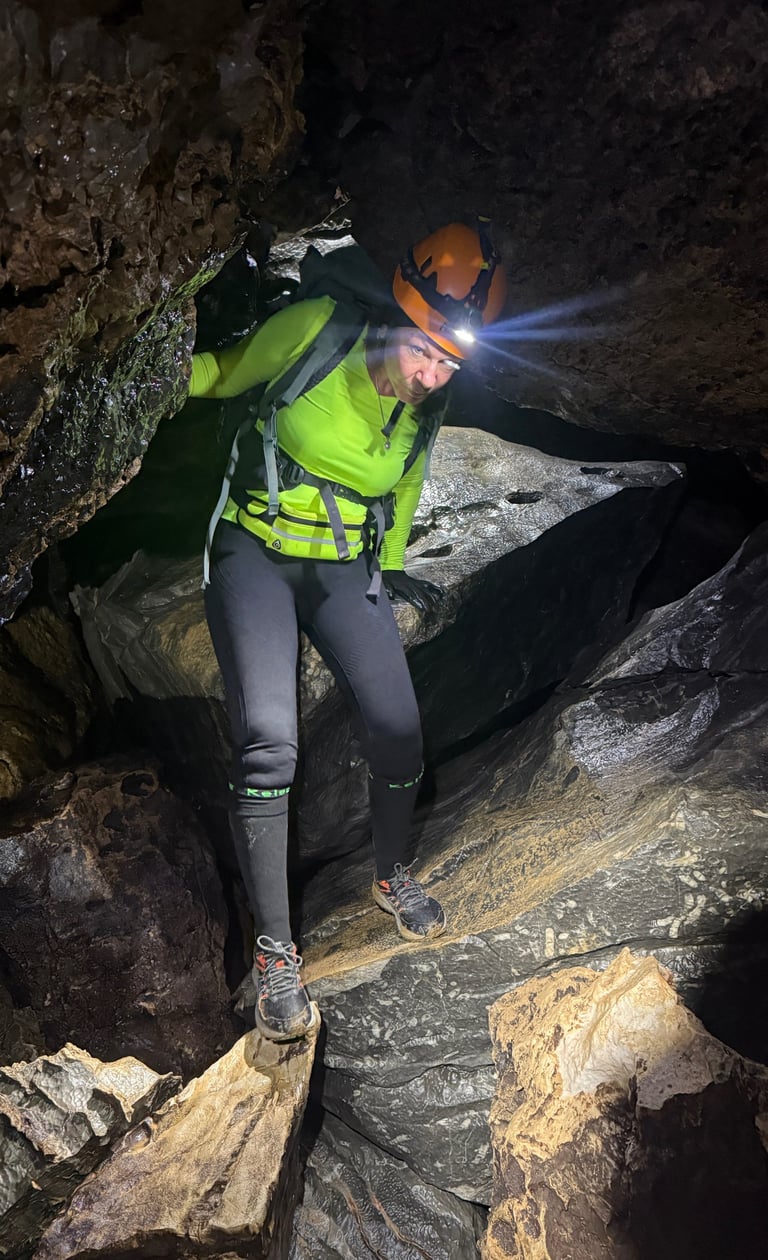

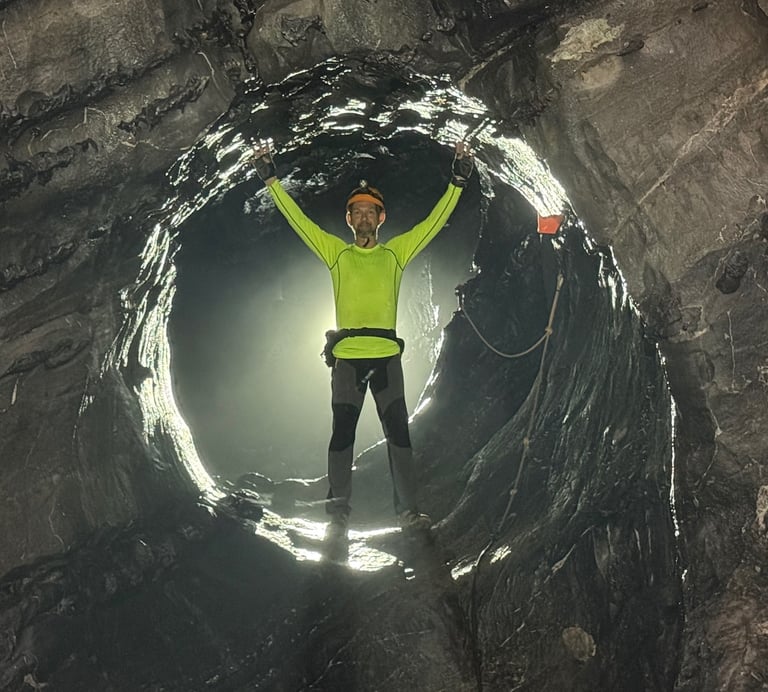

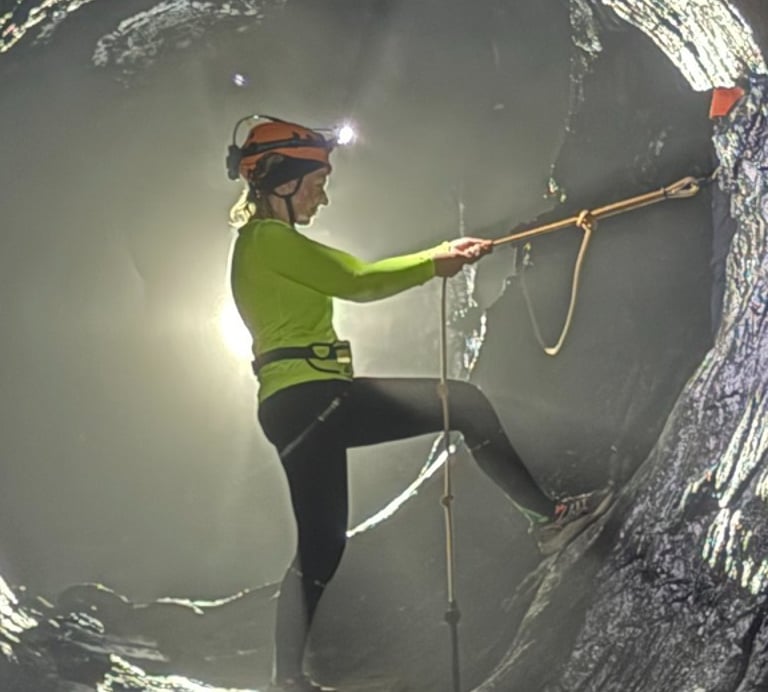

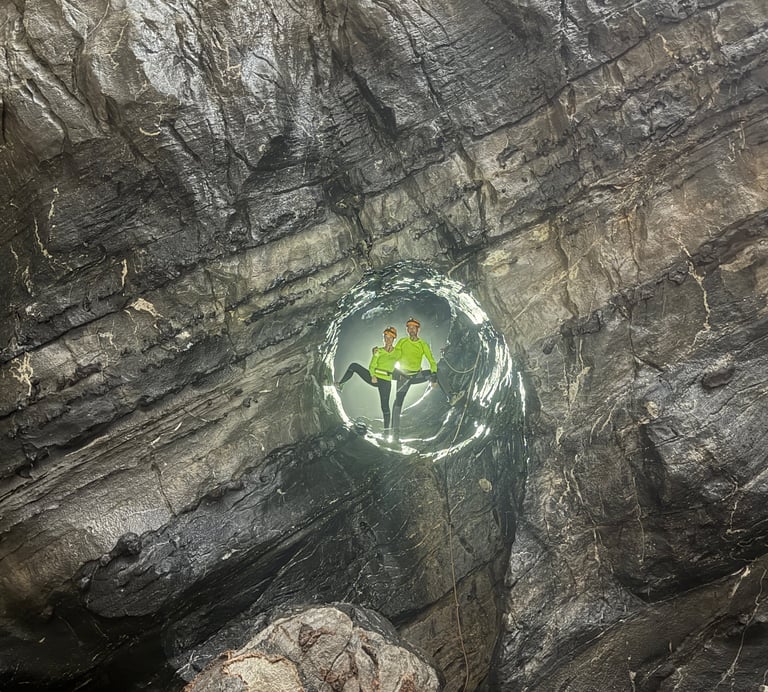

After passing the James bond hole we continued through more large boulder areas until we had to make a steep climb up up a rock slope, this section required the use of ropes and metal ladders to aid our balance and safety. finally making it out into the sunlight of doline 1 known as "Watch Out For Dinosaurs"!
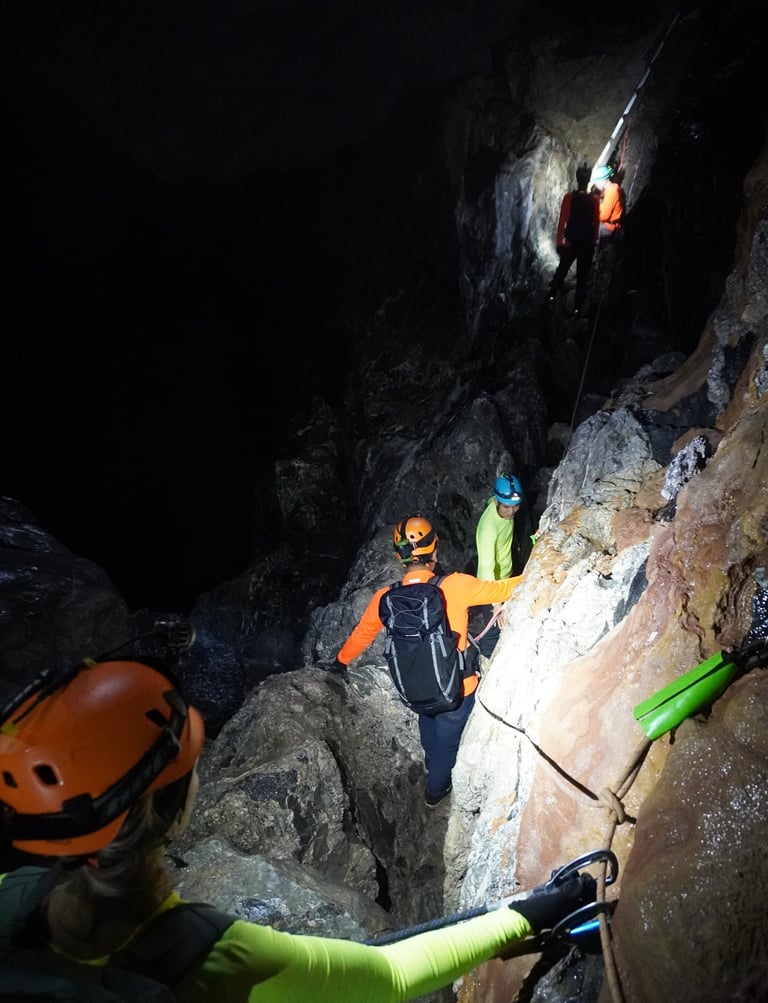

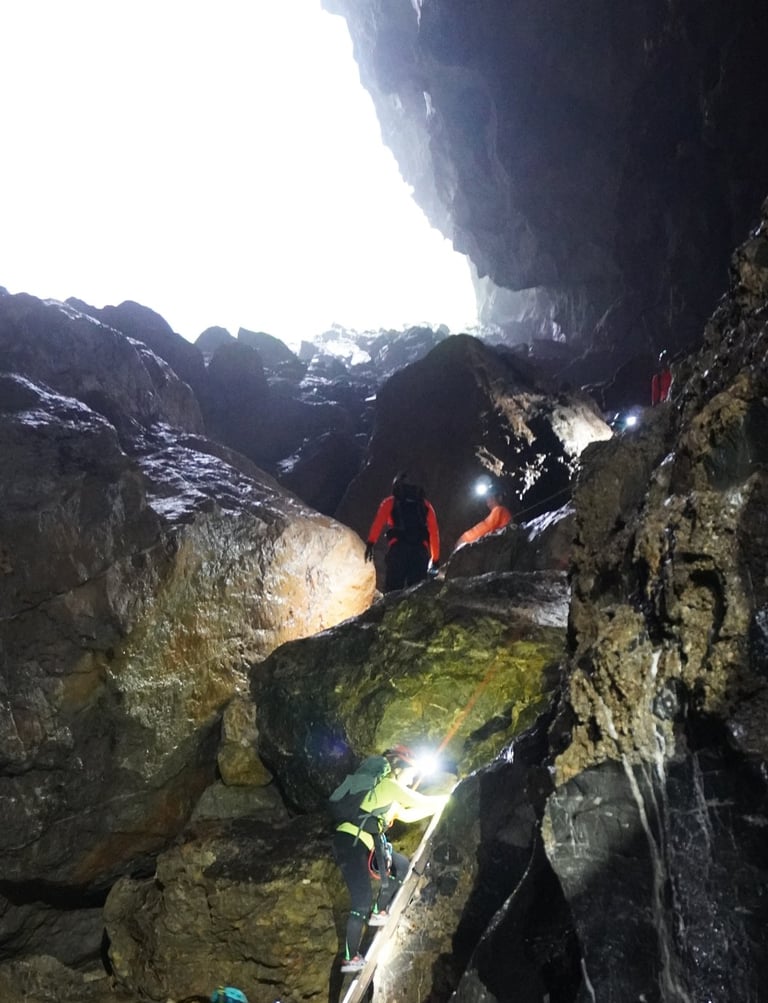

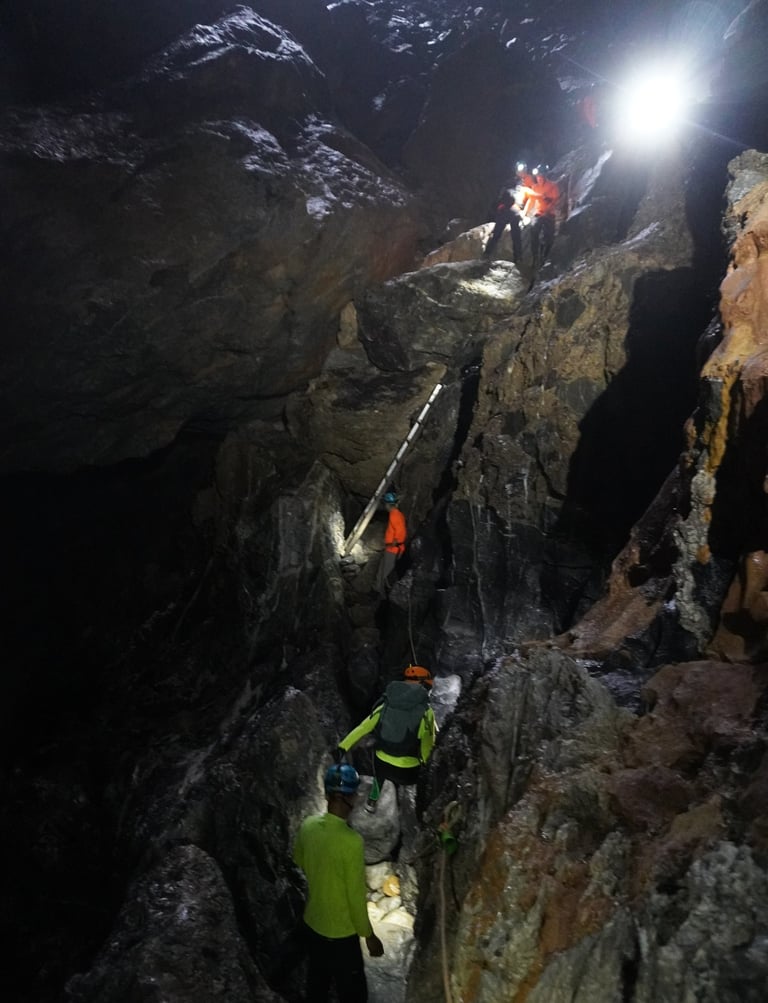

Both dolines were thought to have been formed around half a million years ago when the roof of the main cave collapsed under its own weight forming two large shafts into the cave. Inside these dolines the plants have been isolated for so long that they have evolved to be quite unique to the surrounding jungle. There is also probably the most famous feature of Son Doong in Watch Out For Dinosaurs, thats the Wedding Cake, the remnants of the top of a massive stalagmite formed over many millions of years. Taking it in turns we get the chance to pose for a photo or two on top of this feature. The only feature where a picture of which appears on cans of Huda Beer! We spent quite a bit of time here having a look around and taking photos of the caves entrances, the fauna and doline and it was nice to be out in the sun for a short while, however another highlight of the cave was about to reveal itself as we continued back into Son Doong and down to an area known as "The Green Gours"
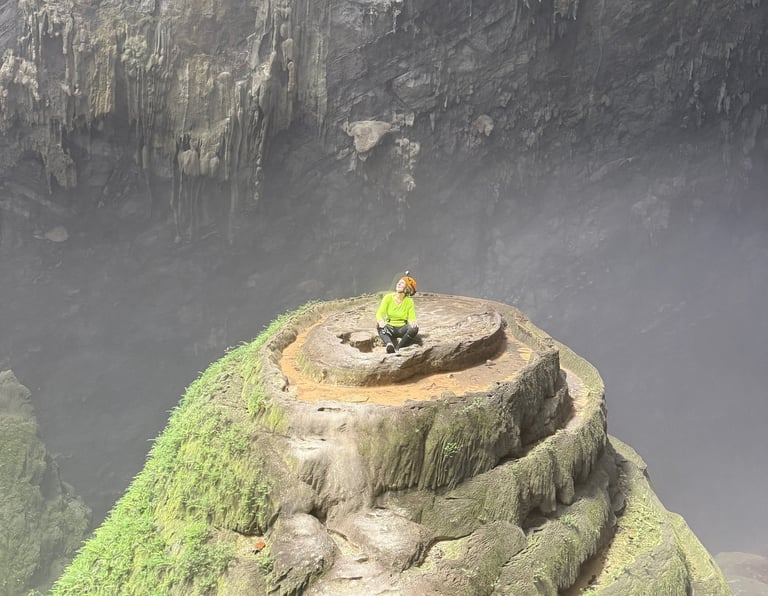

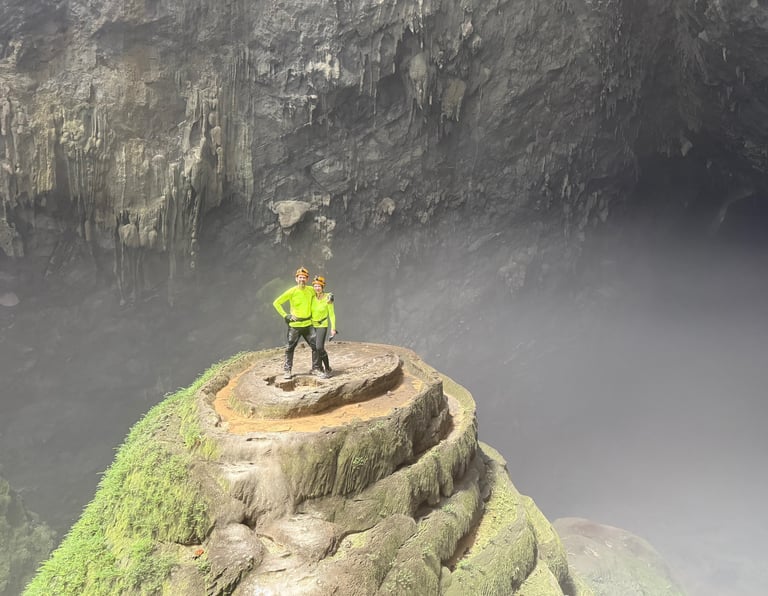

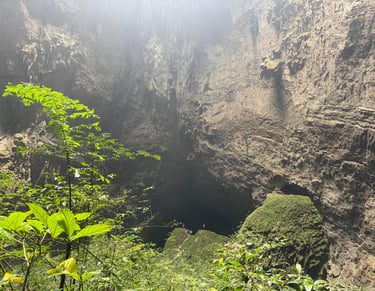

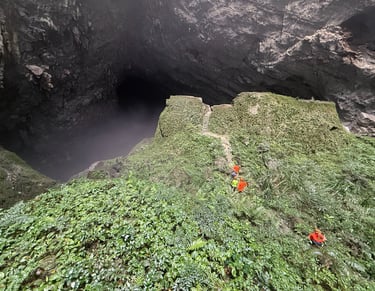

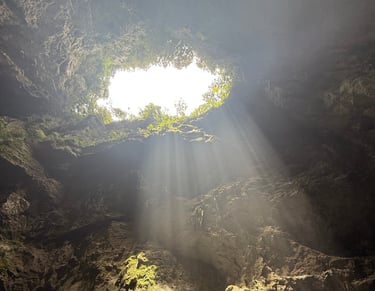

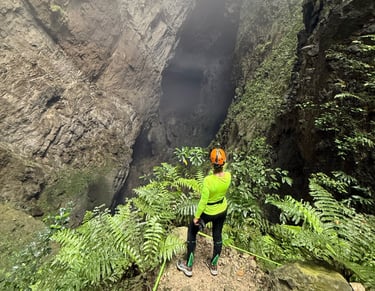

The descent into The Green Gours was again really steep, and you dont realise how big some of the drop offs are until you are down and able to look back on them. The Green Gours was one of my favourite places in Son Dong, there were layers of pristine pools separated by fine calcite formations almost forming terraces, with subtle changes in colour where the light is able to penetrate and allow algae to grow. There is also a pool that catches the reflection of the wedding cake, the doline and the shaft of light that beams down into the doline and moves throughout the day. Again we spent quite a while here, we had dinner and had the opportunity to create a timelapse of the light moving across the cave. I will include links to the time lapse videos at the end.
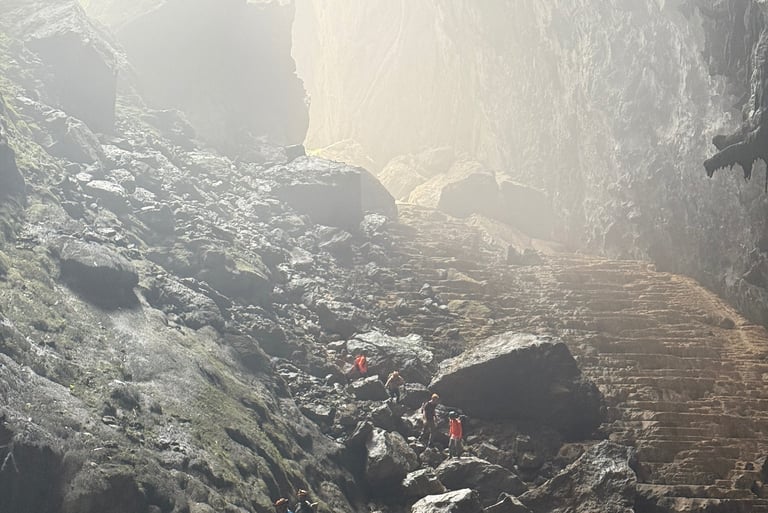


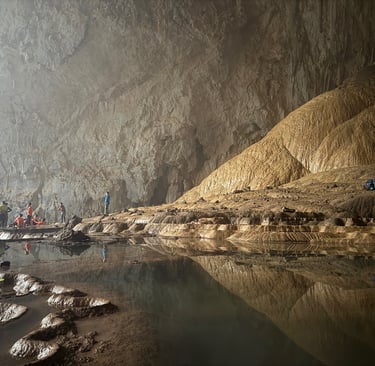
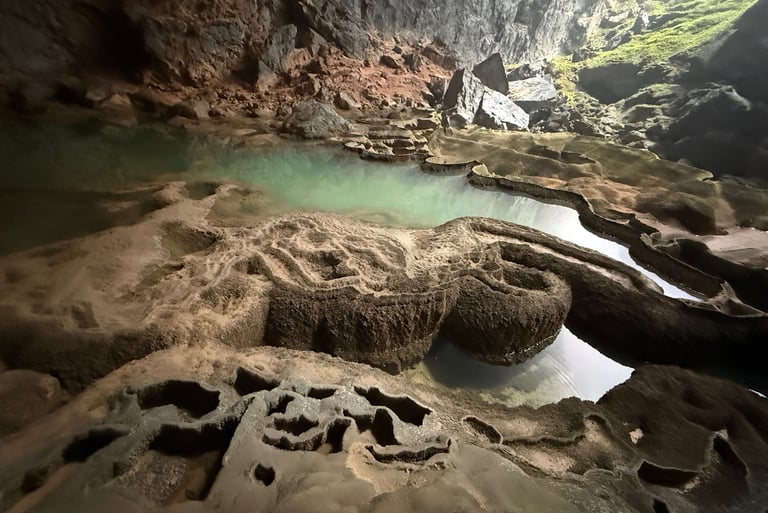


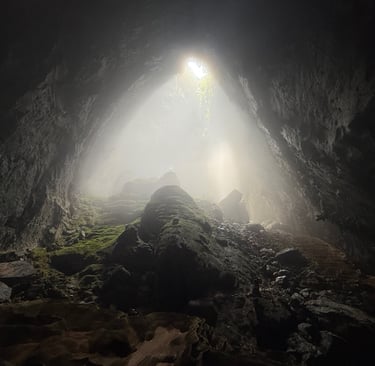
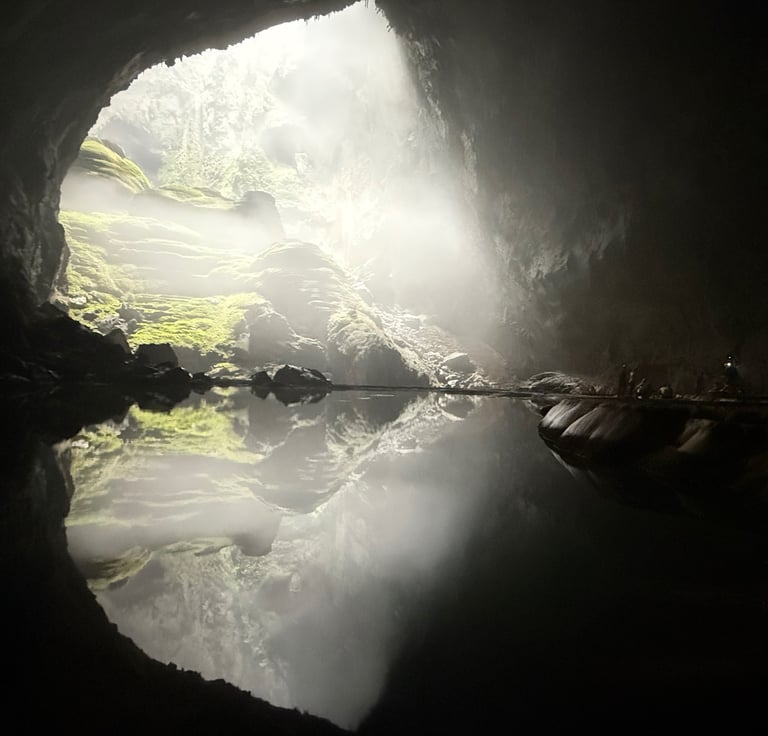

After lunch we continued on, following through more massive chambers and equally massive calcite formations until we reached the final incline before reaching Doline 2 and the "Garden Of Edam" Again we set up the camera to record a short time lapse of the group making the steep climb the Garden Of Edam (Link at the end) and then explored The Garden Of Edam. Pathways here are well marked and you were reminded to stay on the paths as these dolines continue to be a site of scientific interest and disturbance is meant to be kept at a minimum.
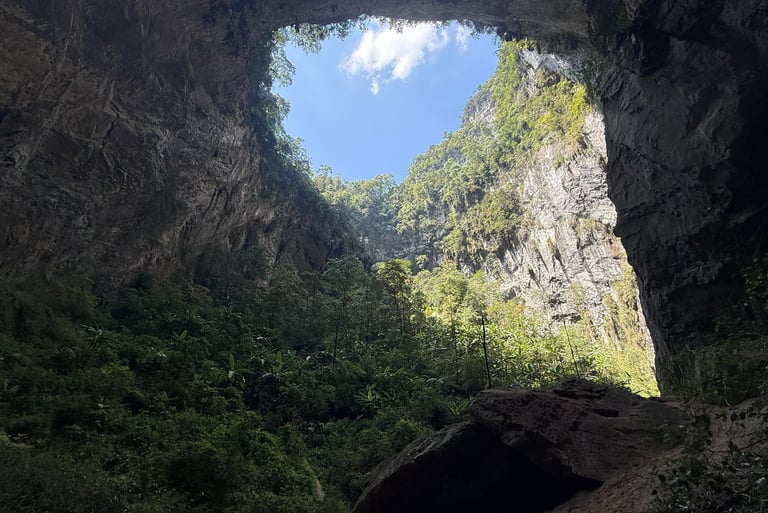


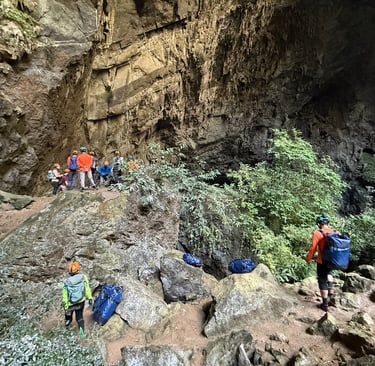
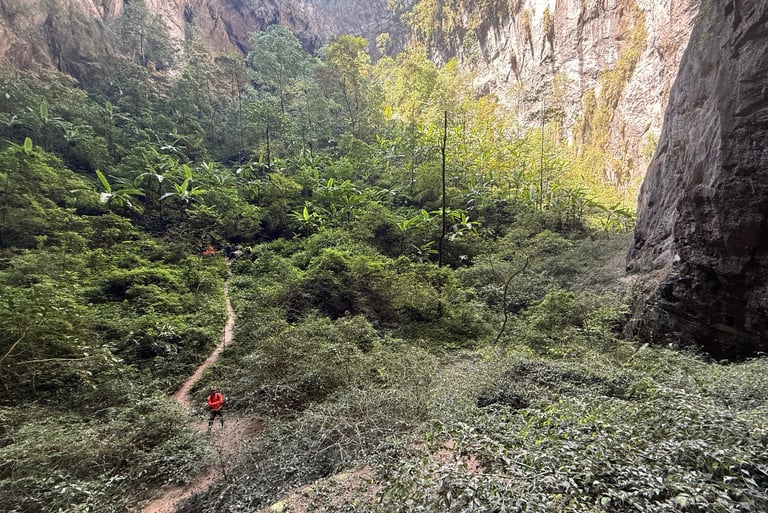

We crossed the Garden Of Edam and started the descent into camp 3. Camp 3 was set up at the bottom of a steep descent and just under the edge of the cave in the continuing passage. Careful navigation was required again as this section was steep and required the assistance of ropes and the safety team at times. Camp was on another sandy plateau, all the kit from the previous night meticulously packed and moved to form this new camp. Once into camp we again had another fantastic meal and plenty of time to check over photos, chill by the charcoal fire or contemplate the following days climb of the Great Wall Of Vietnam! We also managed to get a guest group photo of the 10 of us on the trip and also a whole expedition team photo (with exception of two of the porters who took the photos).
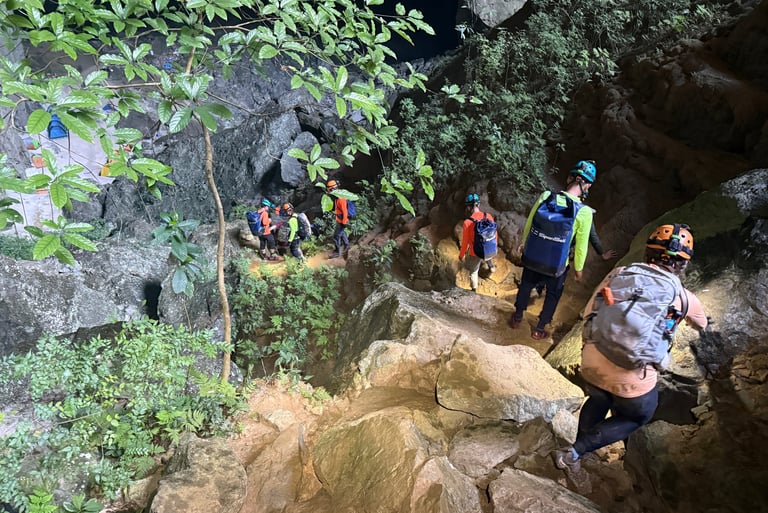

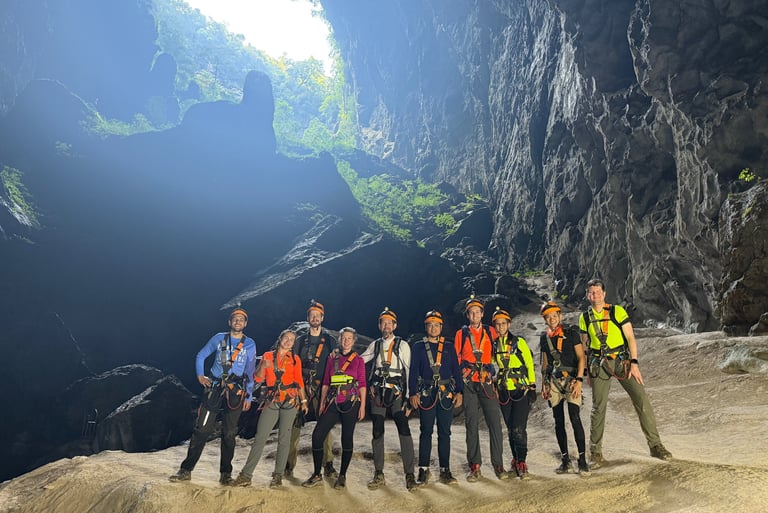

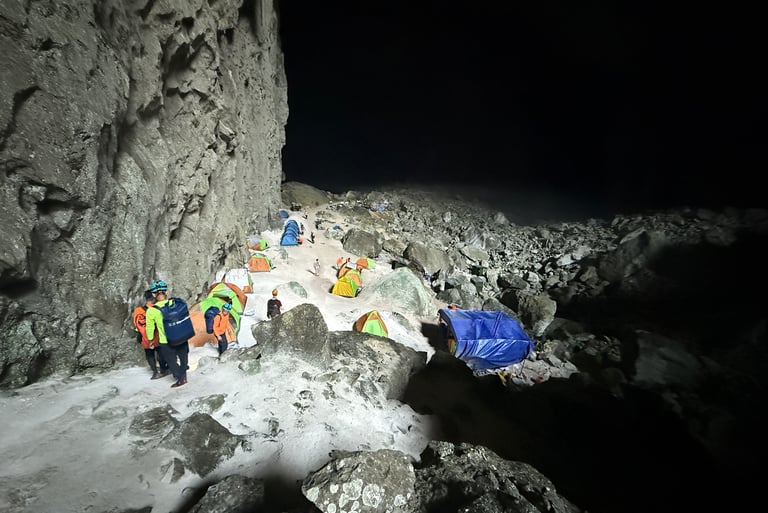


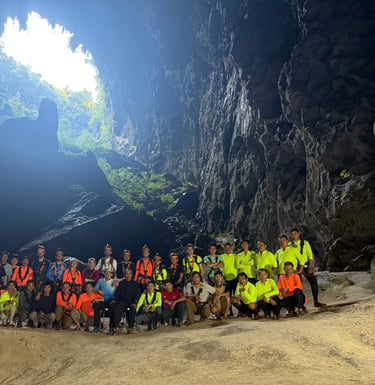
The following morning we woke with a touch of sadness that this was going to be our last day in Son Doong, a little trepidation at the thought of climbing the Great Wall Of Vietnam and a little excitement at getting out of the cave, having a proper shower and sleeping in a comfortable bed that night! We were up early as usual and packed ready to go after our final feast of a breakfast, then the safety team gave us a briefing on our kit for the day as we were climbing the Great Wall of Vietnam, they needed to fit us all with full harnesses again and showed us how to use special rope ascenders for our safety. Finally we were off, climbing over a boulder field and then dropping onto a large flat, wide cave floor, you could tell that this part of the cave was massive as the cave swallowed the lights from all who wore them. Continuing on to a section of the cave known as "The Sublime To The Ridiculous"
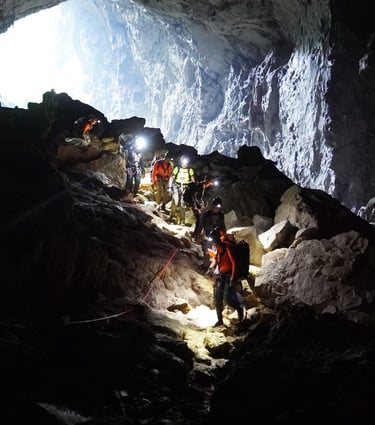

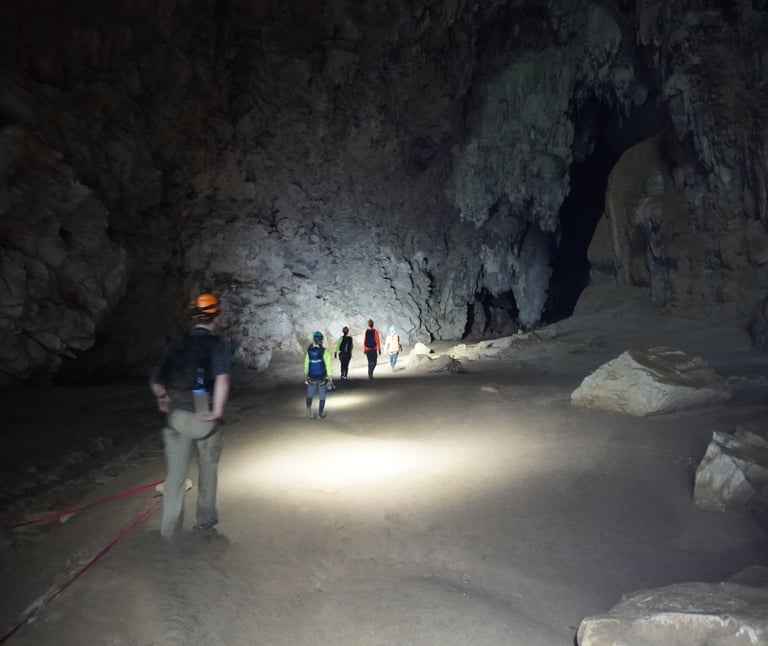

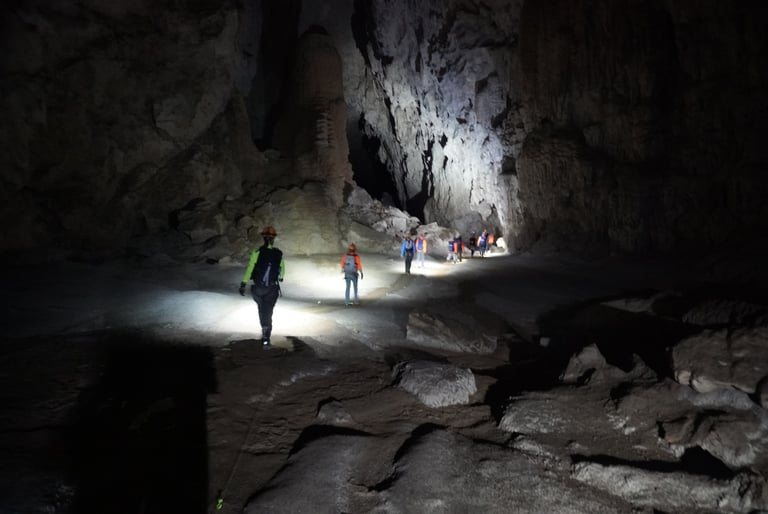

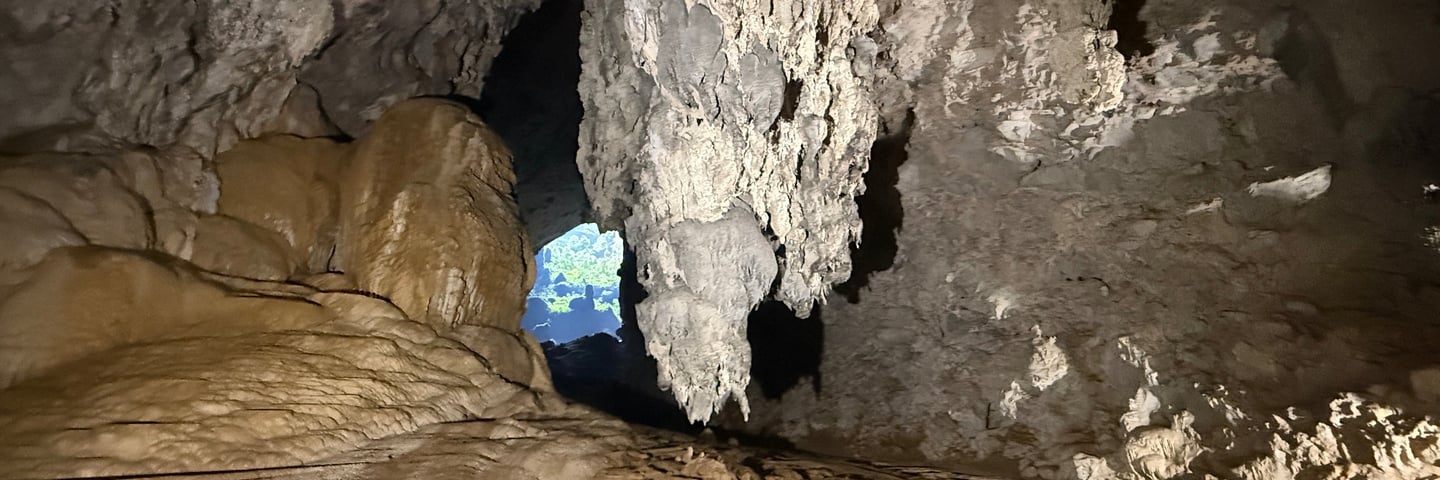

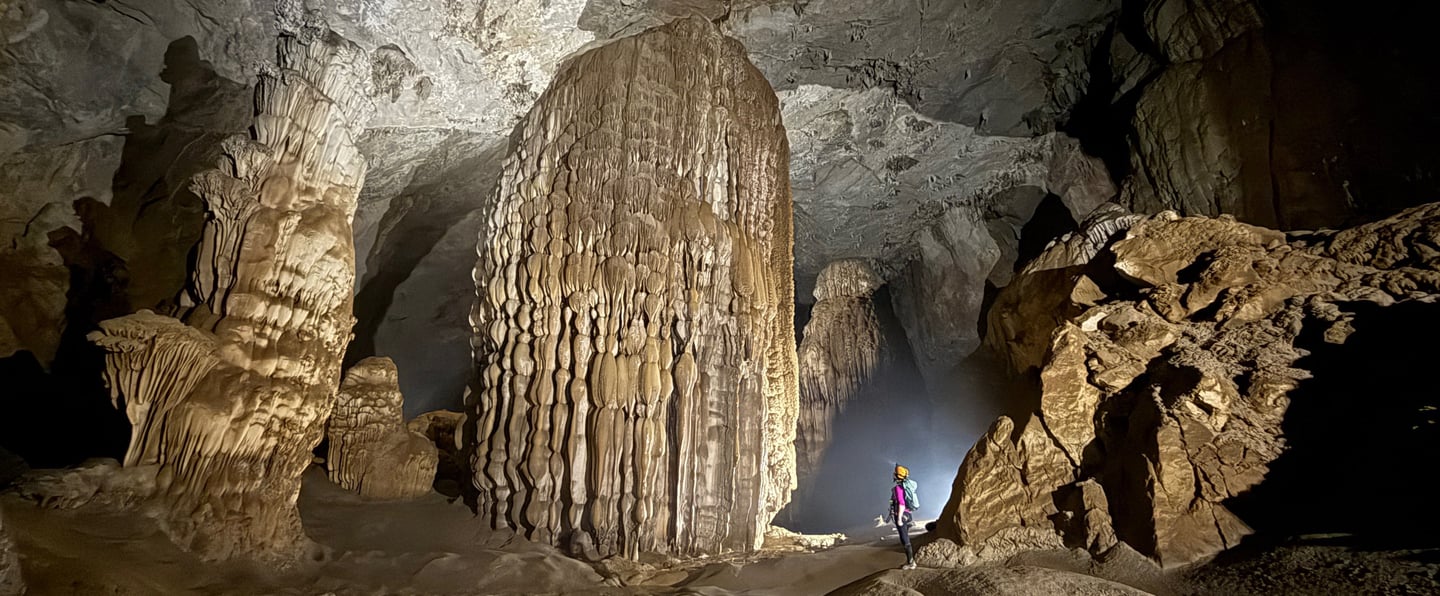

Within Son Doong you do find the odd creature lurking in the darkness, none of which are anything to worry about, but all of them do share a few common traits, they are all colourless and all blind. This section of the cave was great for our guides to show us a few examples. In the shallow pools at the bottom of the huge stalagmites there were blind white fish swimming about. We also found a few quite large spiders and a few cave louse.
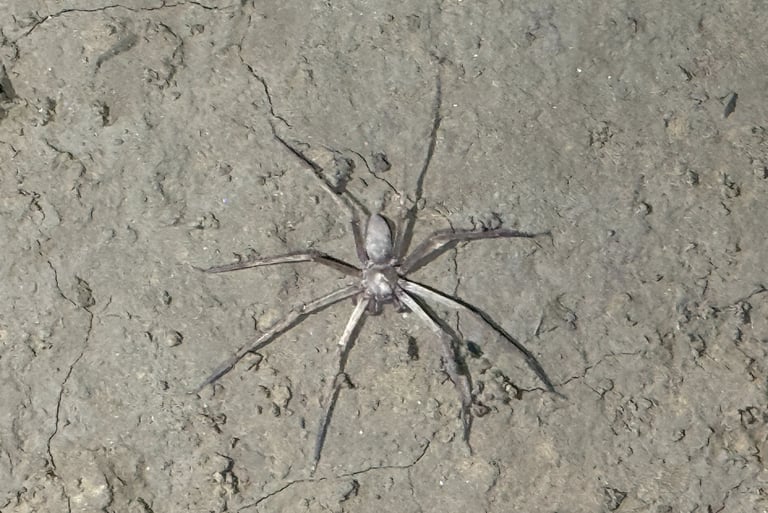

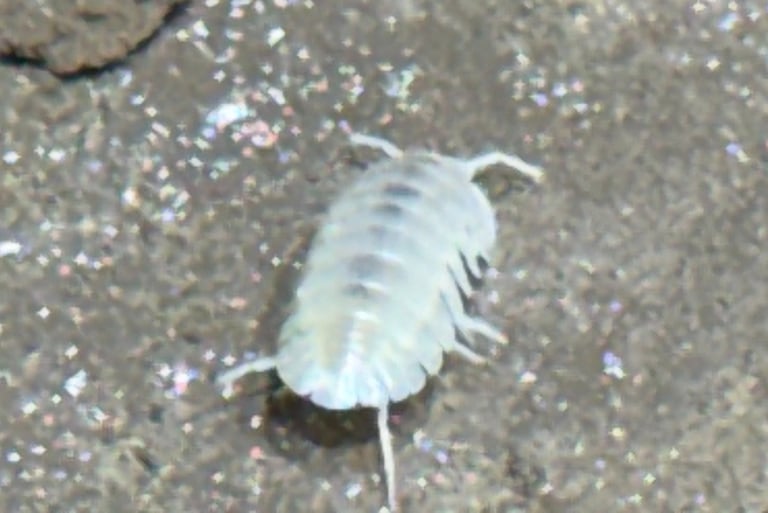

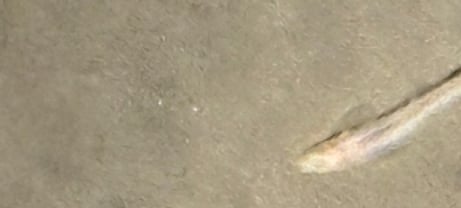

In this section you also find the "Jewells of the cave" the cave pearls. These are small calcite formations that have formed independently from the dripping water that was too fast to form stalactites. These cave pearls form over several hundred years, gaining sive and then eventually rolling down so that the lower ones are always the biggest
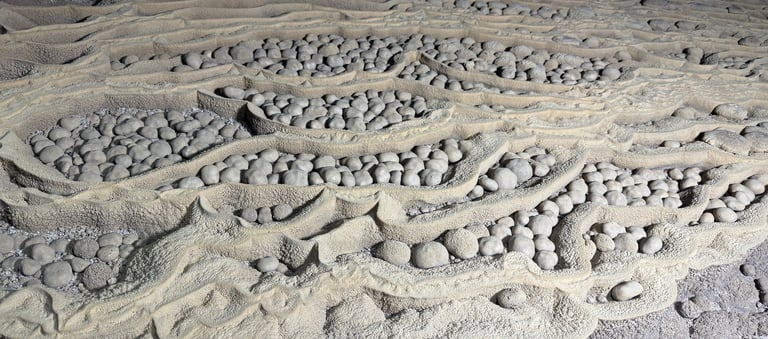

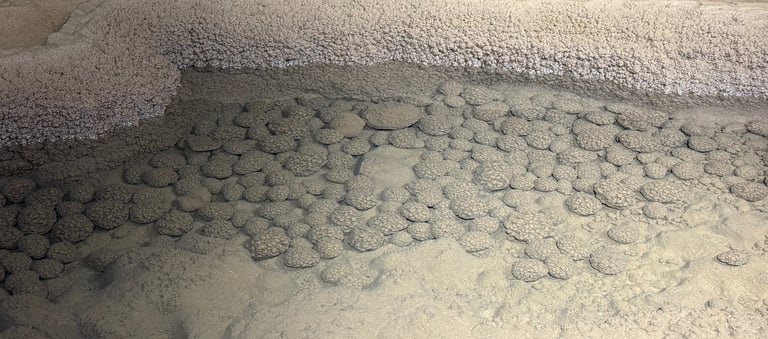

Finally we reached the area in the cave called Passchendaele, named after the muddy battlefield of the first world war. Depending on the time of year and how the rain has been outside this section can be a large lake or a very muddy scramble. We were in luck an Passchendaele was flooded and we had to take a raft across the lake over half a kilometer to the bottom of the Great Wall Of Vietnam. Our safety kit was checked before we got onto the raft and our shoes were washed clean of mud once we were on the raft as it was important to have clean shoes for the ascent of the large calcite wall.
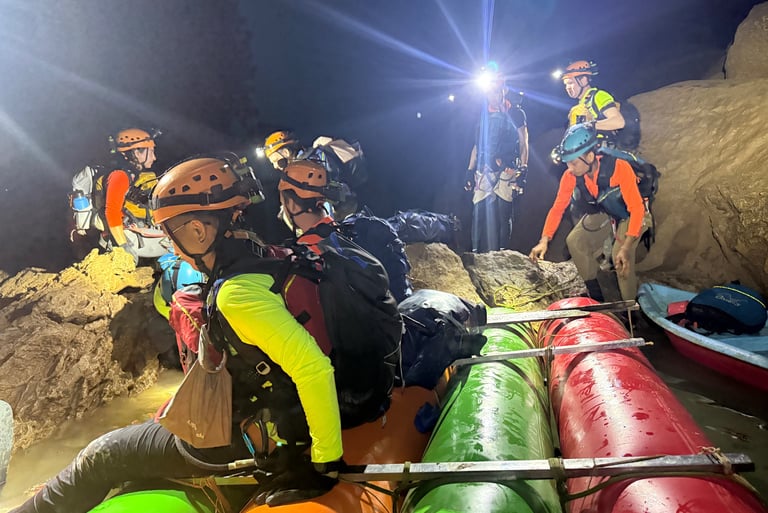

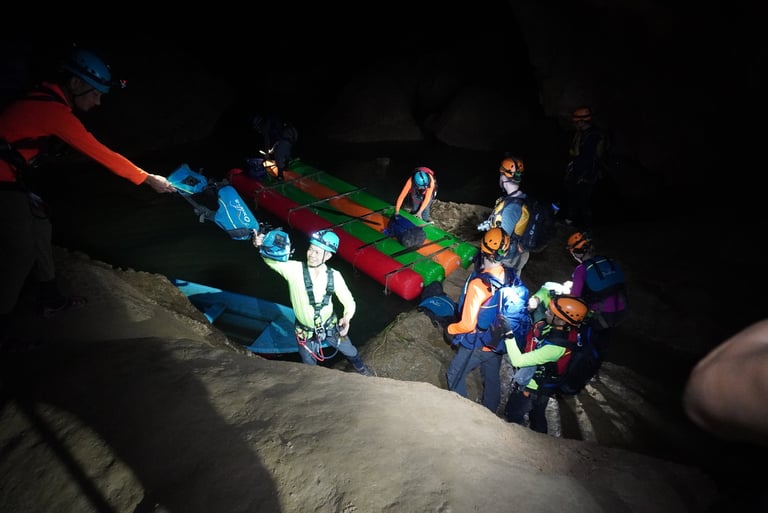

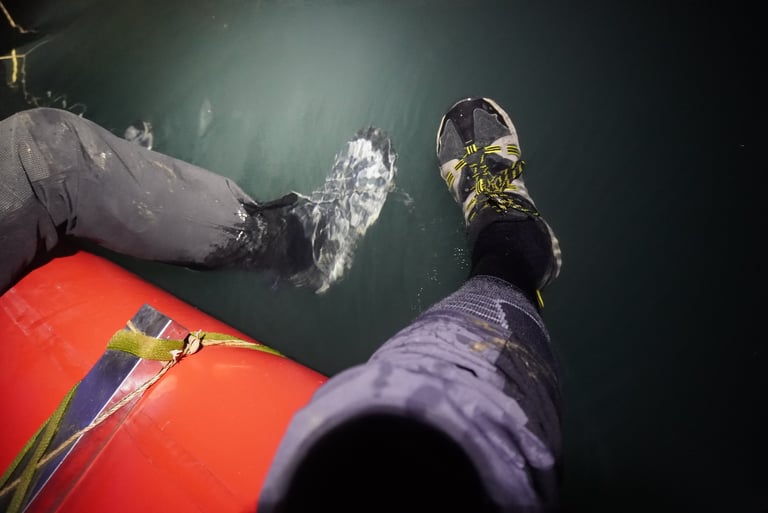

After the slow raft ride we eventually reached the base of the Great Wall of Vietnam, a 90m calcite wall that initially had stopped the original cave explorers from getting all the way through Son Doong as the first 20m is a sheer smooth wall. So our raft settled at the base of what now has a fixed section of metal ladder approximately 18m high, this gets you out of the water and up and onto a ledge where you then have to heave yourself up two further sections on knotted ropes, each sections was around 30m high. A member of the safety team was at the top and bottom of each section and you were also attached to a safety rope, but you still have to pull yourself up the extremely steep, wet and slippy calcite wall.
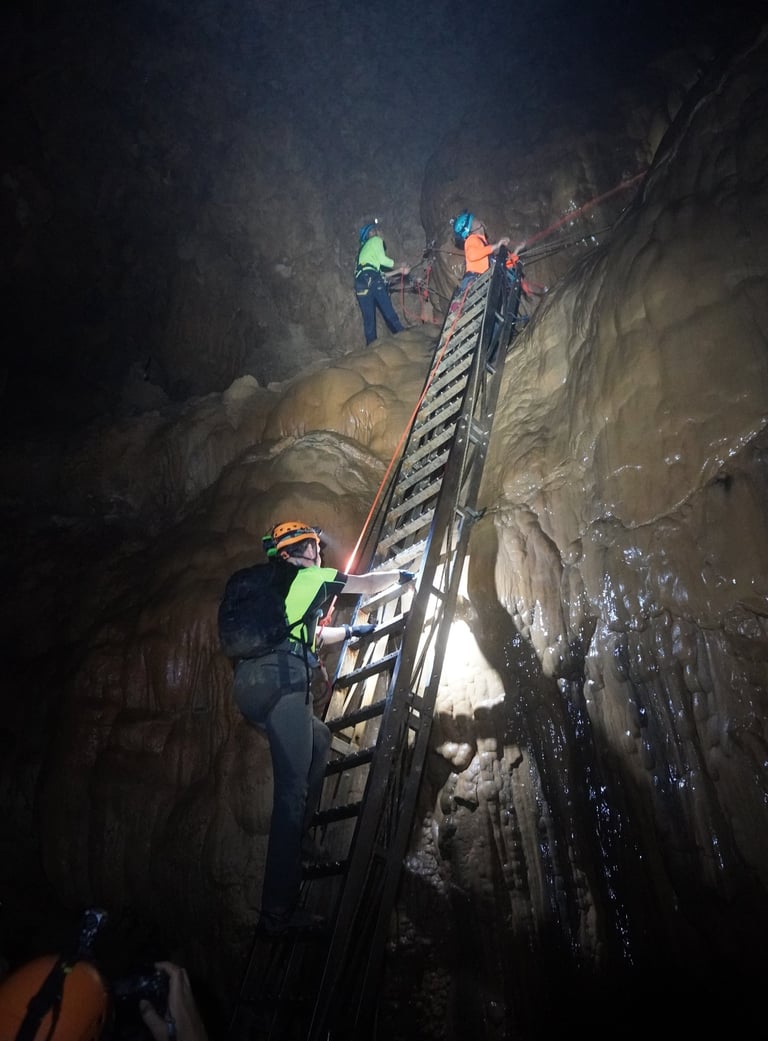


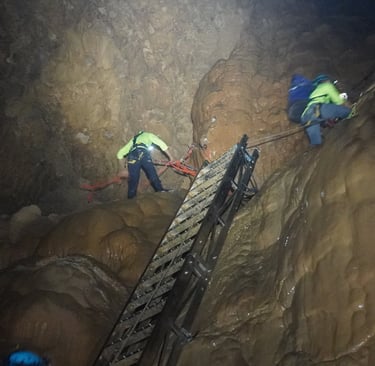
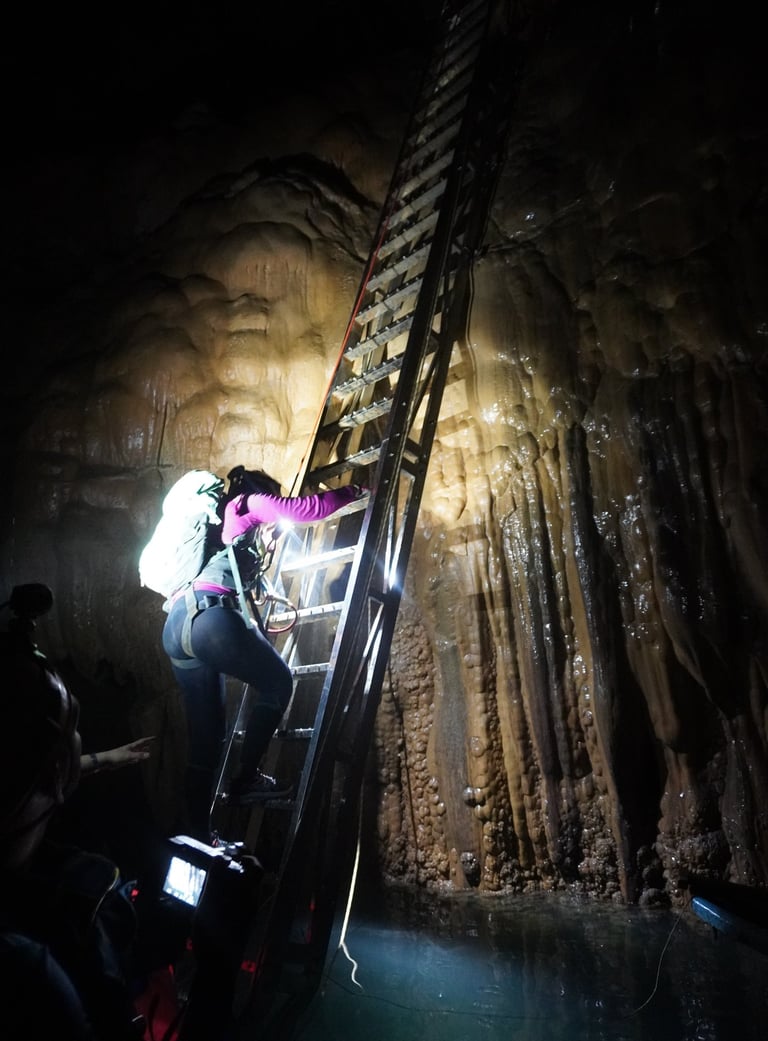

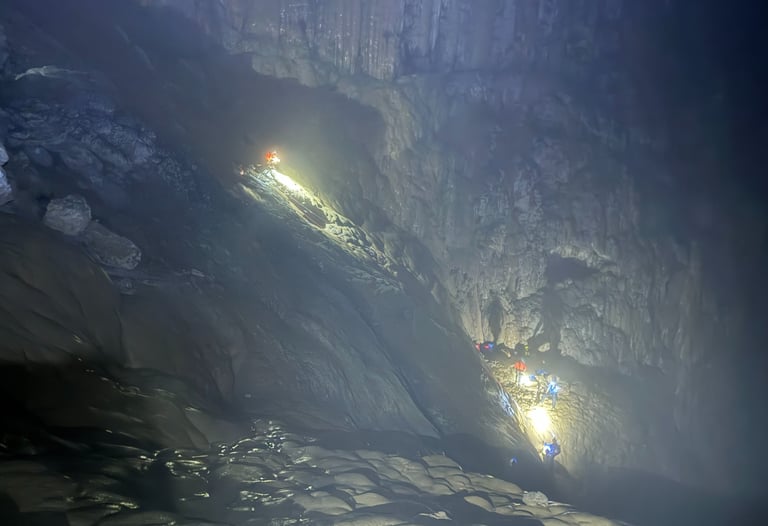

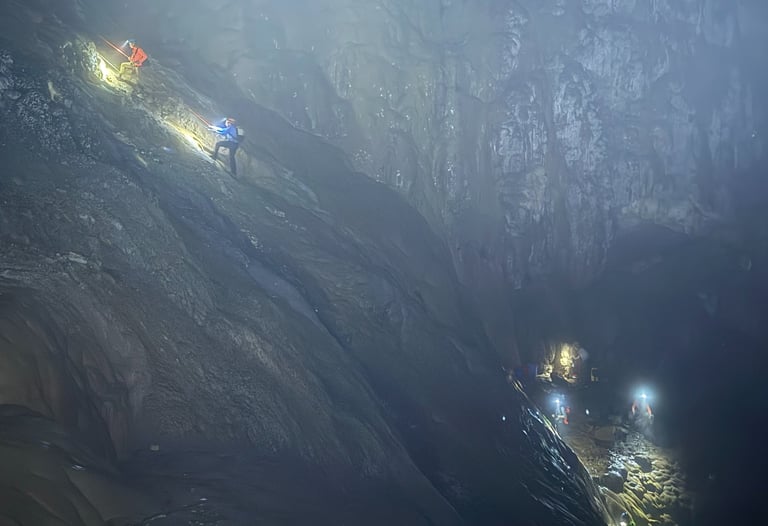

Finally when we were all at the top we got to relax a little, the people that went up first got the best view as there was a great vantage point on a small ledge adjacent to the climb. Once we were all safe we sat down and had our last dinner in the cave before proceeding on through the last 500m or so, passing some petrified bear bones on the way, heading up our last steep rocky section and out of the cave, back into the baking hot sun!
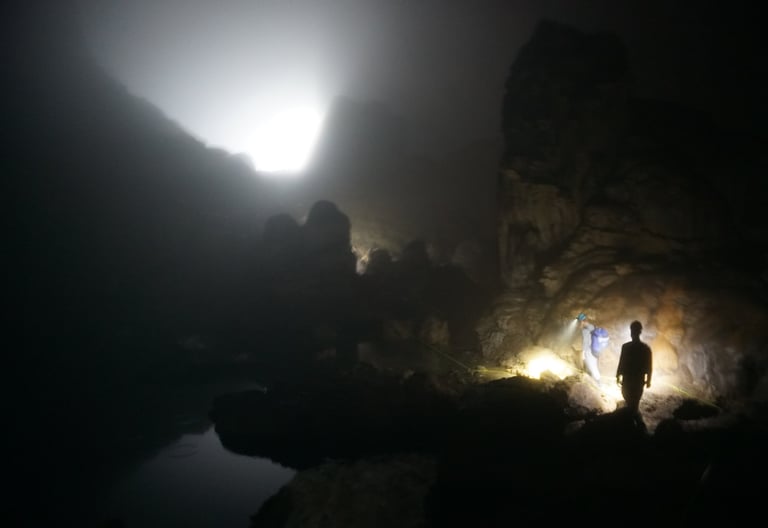

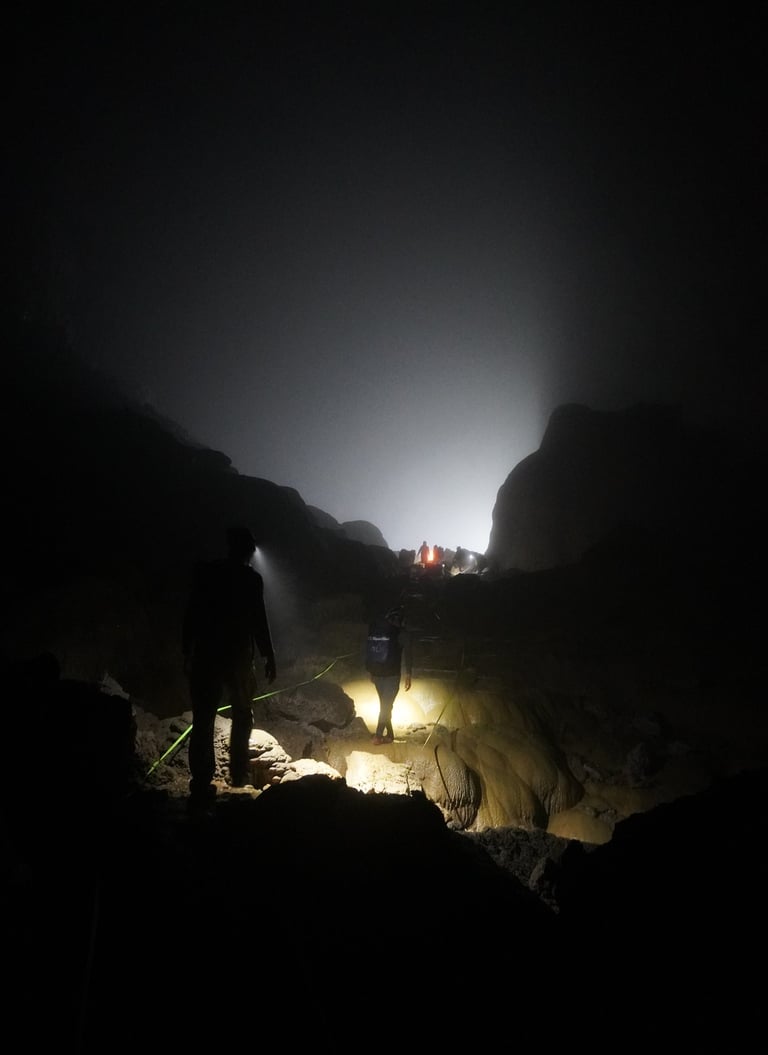

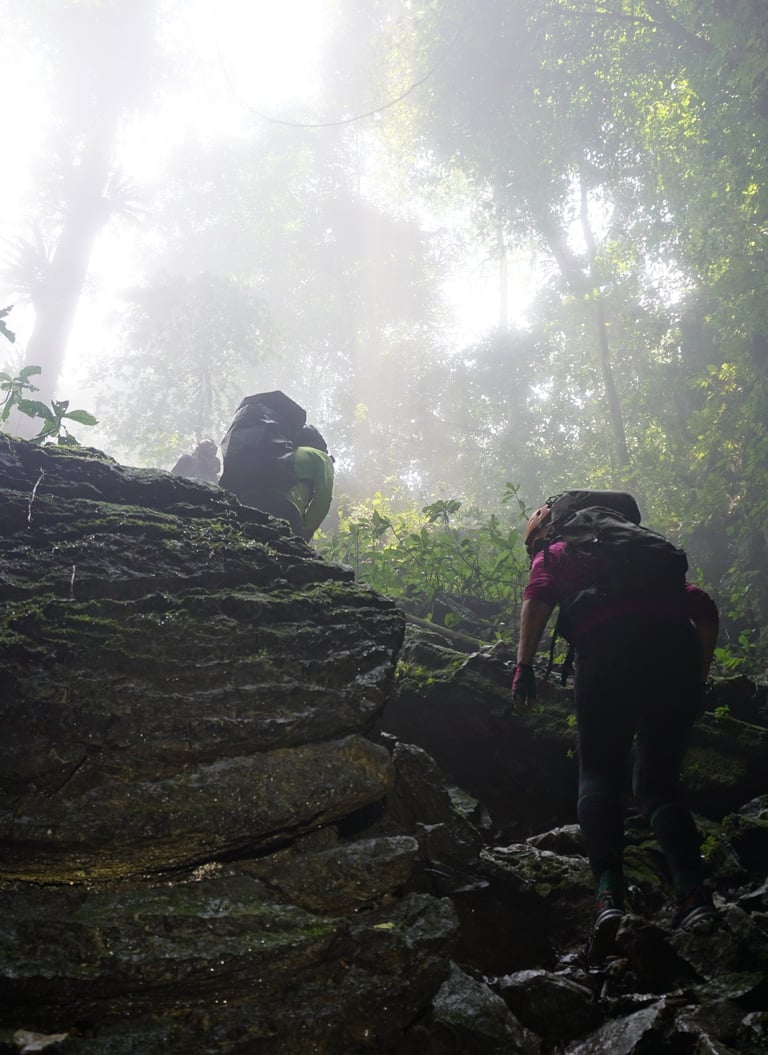

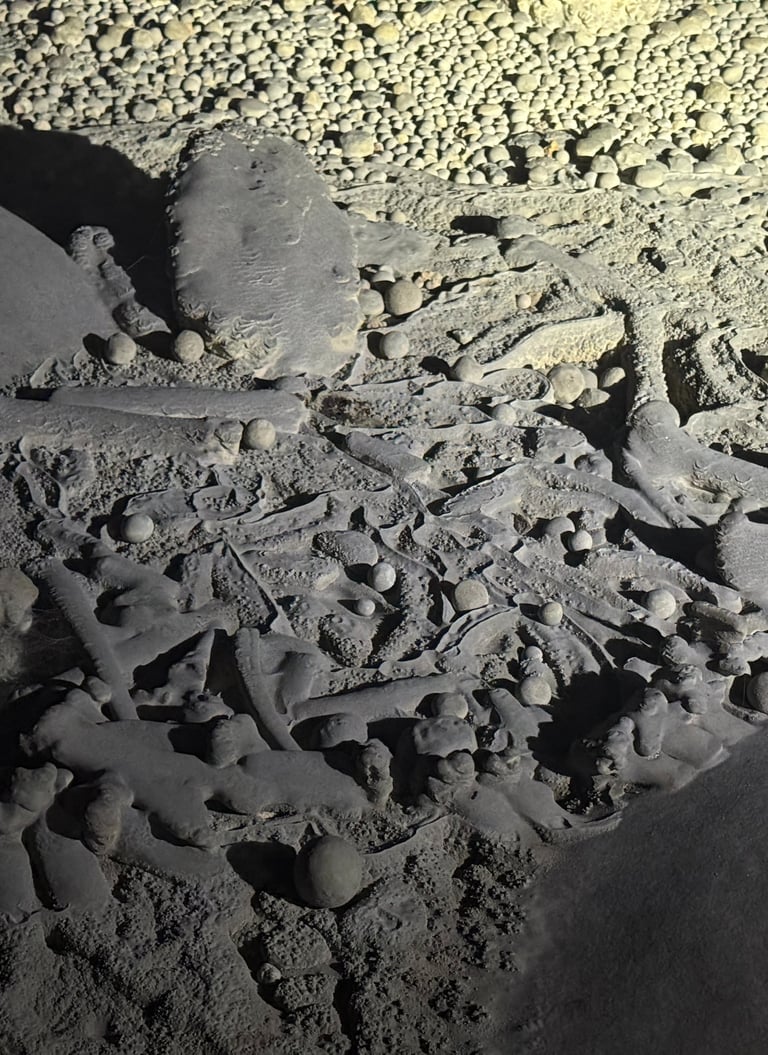

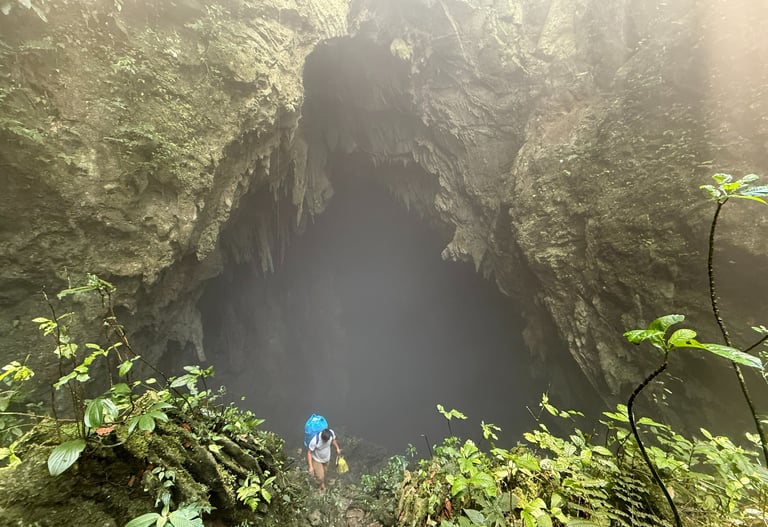

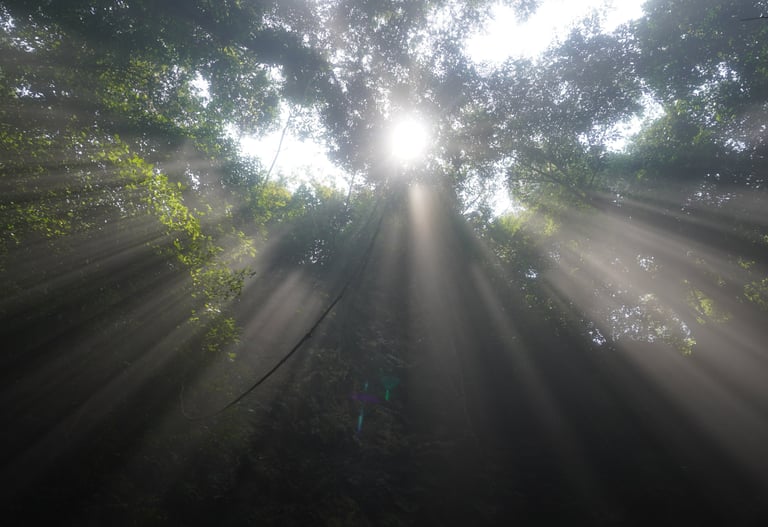

Finally out of Son Doong there was still a couple of miles to trek through the jungle, down some extremely jagged and sharp rock formations and across another river before we finally reached Ho Chi Minh Road and our lift back to civilisation, but not before a cold beer (with a picture of the Wedding Cake on it!) and a group congratulation for completing an expedition through the worlds largest cave, Hang Son Doong...The Mountain River Cave!
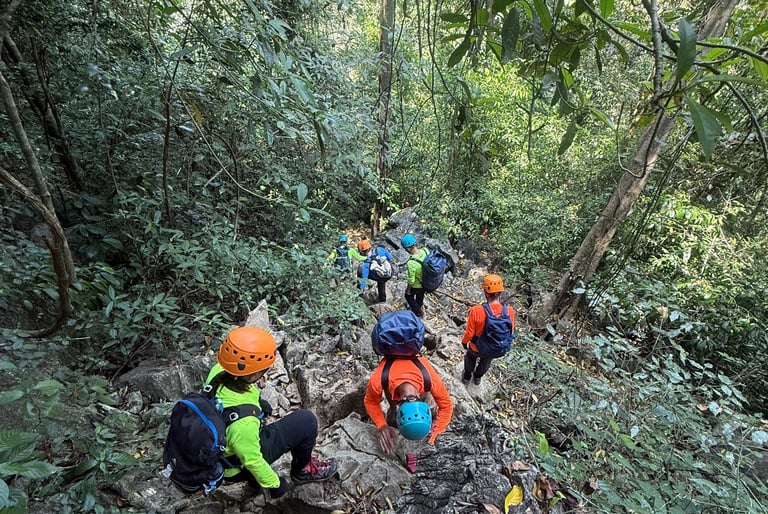

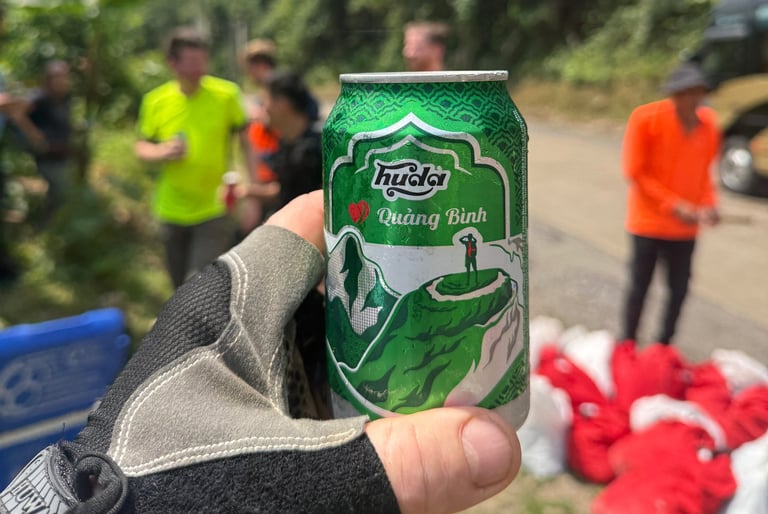

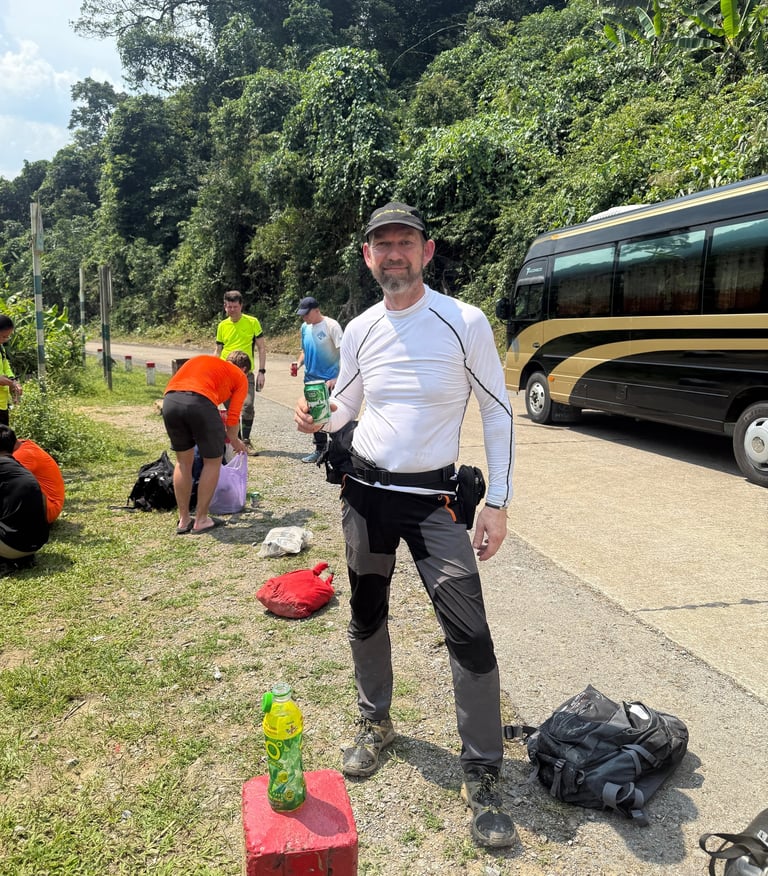

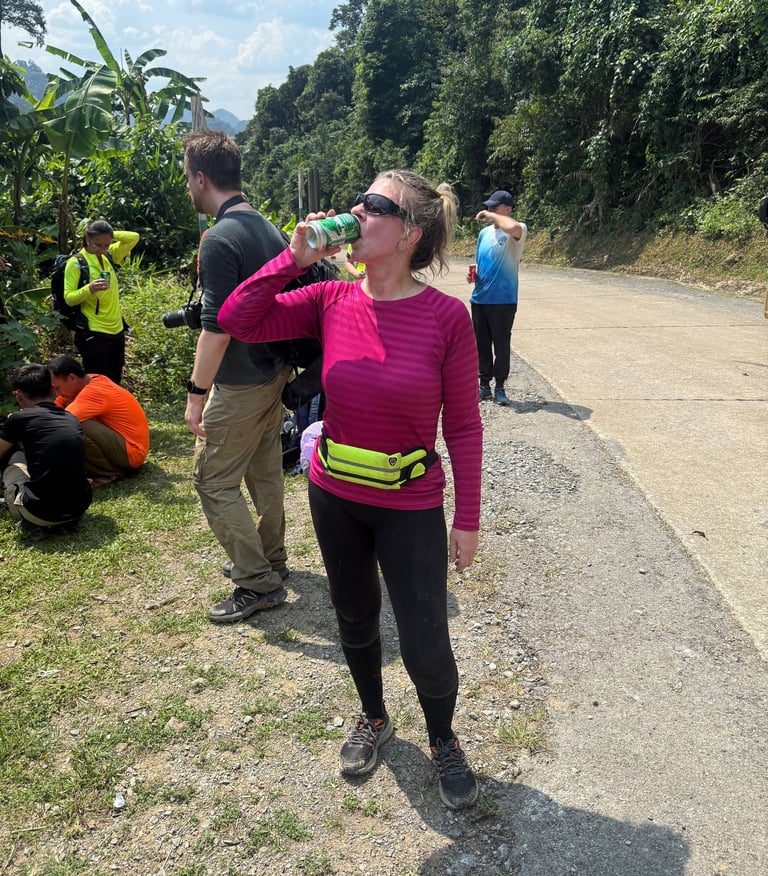

Following our beer we were taken to the Chay Lap Farmstay back in Phong Nha where we were welcomed with a champagne reception and where we spent our final night. The farmstay offered the chance to chill out, borrow a bicycle to explore a bit or go take a canoe down the river. You also got the chance to sort out your things and get some washing done if you wanted it.
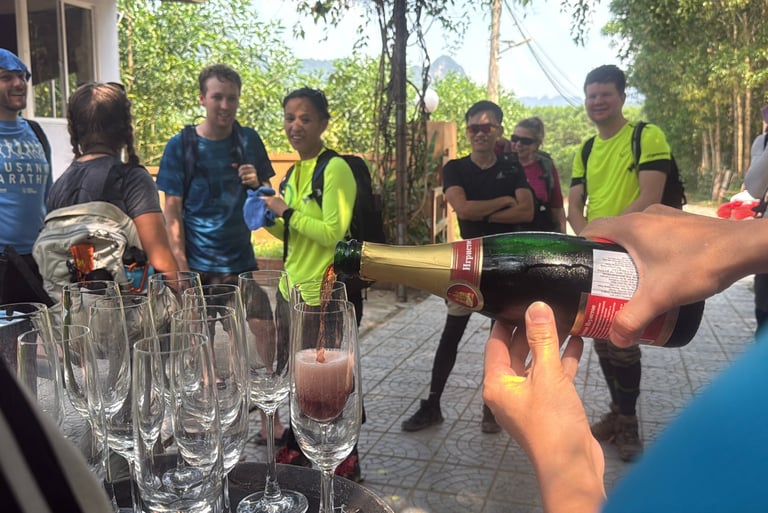

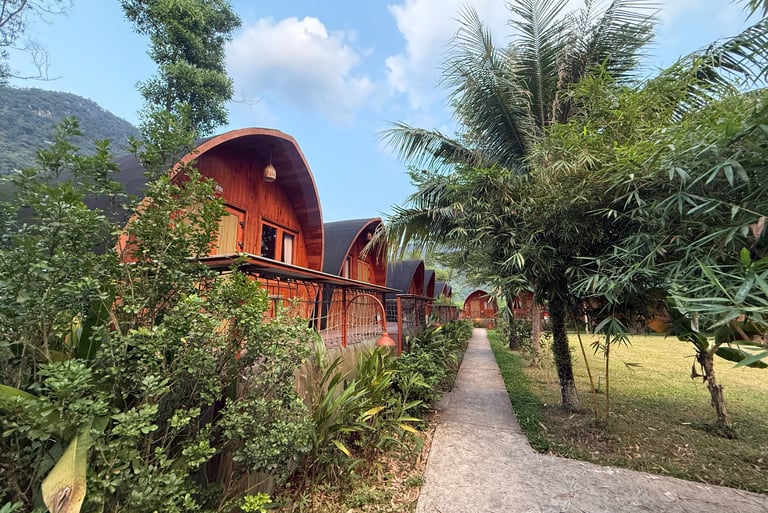

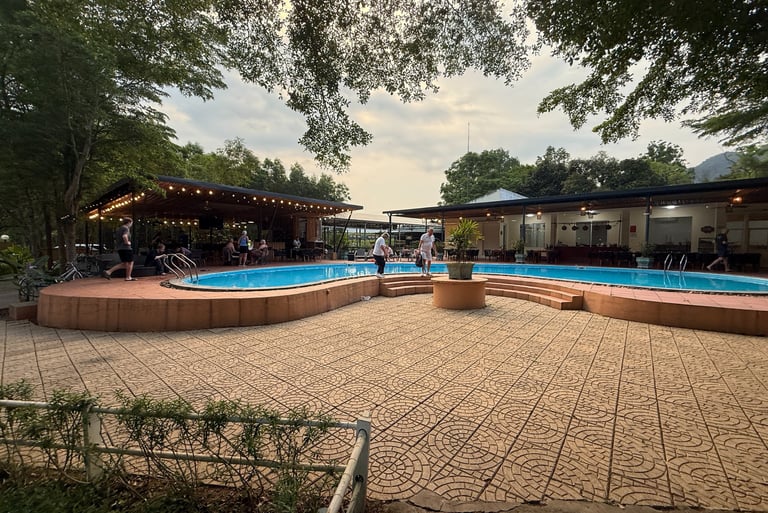

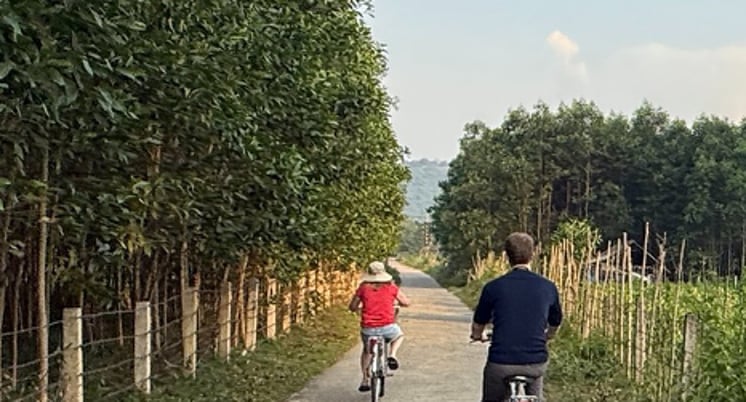

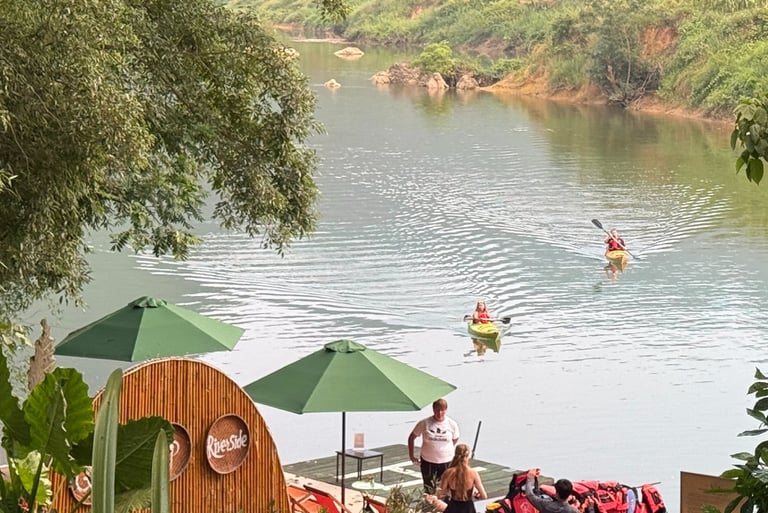



The final thing that we did as a group was to enjoy and evening meal together, this time it was accompanied by free beer or spirits, good chat and a final presentation of our Hang Son Doong completion medal by Martin our expedition leader. In the morning we parted company and continued or travels through Vietnam, we moved hotels and stayed on in Phong Nha for a few more days as the are is stunning and the was more to explore nearby.
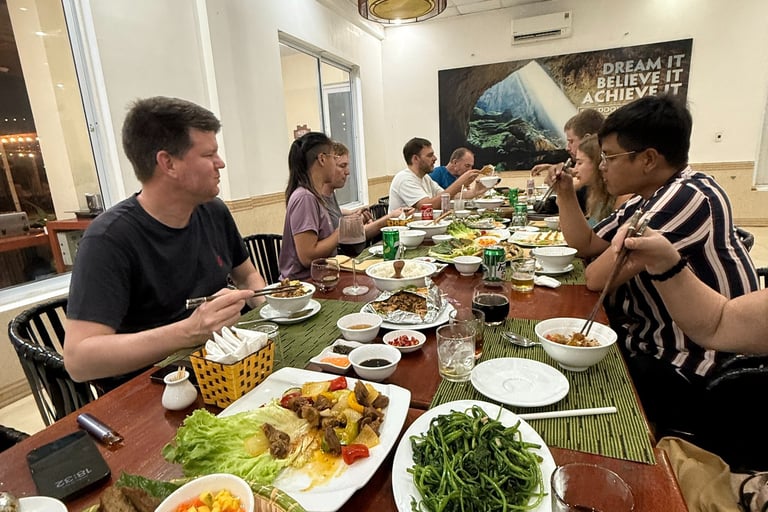


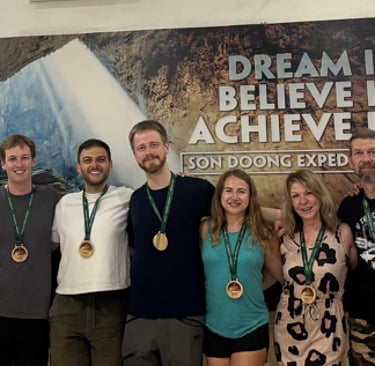




Follow the links below for timelapse videos in the cave
